What Is LinkedIn Marketing?
LinkedIn marketing is the act of using LinkedIn to promote your personal or professional brand, expand your network, grow exposure, and build trust.
LinkedIn marketing takes on different forms when used for personal and business purposes. Both strategies aim to build a network and establish credibility, but their approaches and goals can differ significantly.
Personal Use
When individuals use LinkedIn for personal marketing, the focus is on career development and personal branding. Professionals showcase skills, experience, and achievements to connect with peers, industry leaders, and potential employers.
Personal LinkedIn marketing involves creating a compelling profile, creating and sharing content, and networking.
Business Use
Businesses use LinkedIn marketing to promote their brand, products, or services to a targeted audience. This strategy focuses more on lead generation, sales, and content marketing.
Business LinkedIn marketing can include creating a company page, posting job ads, exhibiting thought leadership, and sharing helpful content.
Why Is LinkedIn Marketing Important?
While LinkedIn can be a great place to showcase skills, network, build a personal brand, and find jobs, it’s particularly effective for business-to-business (B2B) marketing.
In fact, LinkedIn data shows that 93% of B2B content marketers use LinkedIn for organic social marketing.
Why? Because LinkedIn helps businesses reach and engage their audience more than other platforms.
Seventy-seven percent of users say LinkedIn produces the best organic results. Impressively, messages on the platform, including cold outreach efforts, have four times higher open rates than email.
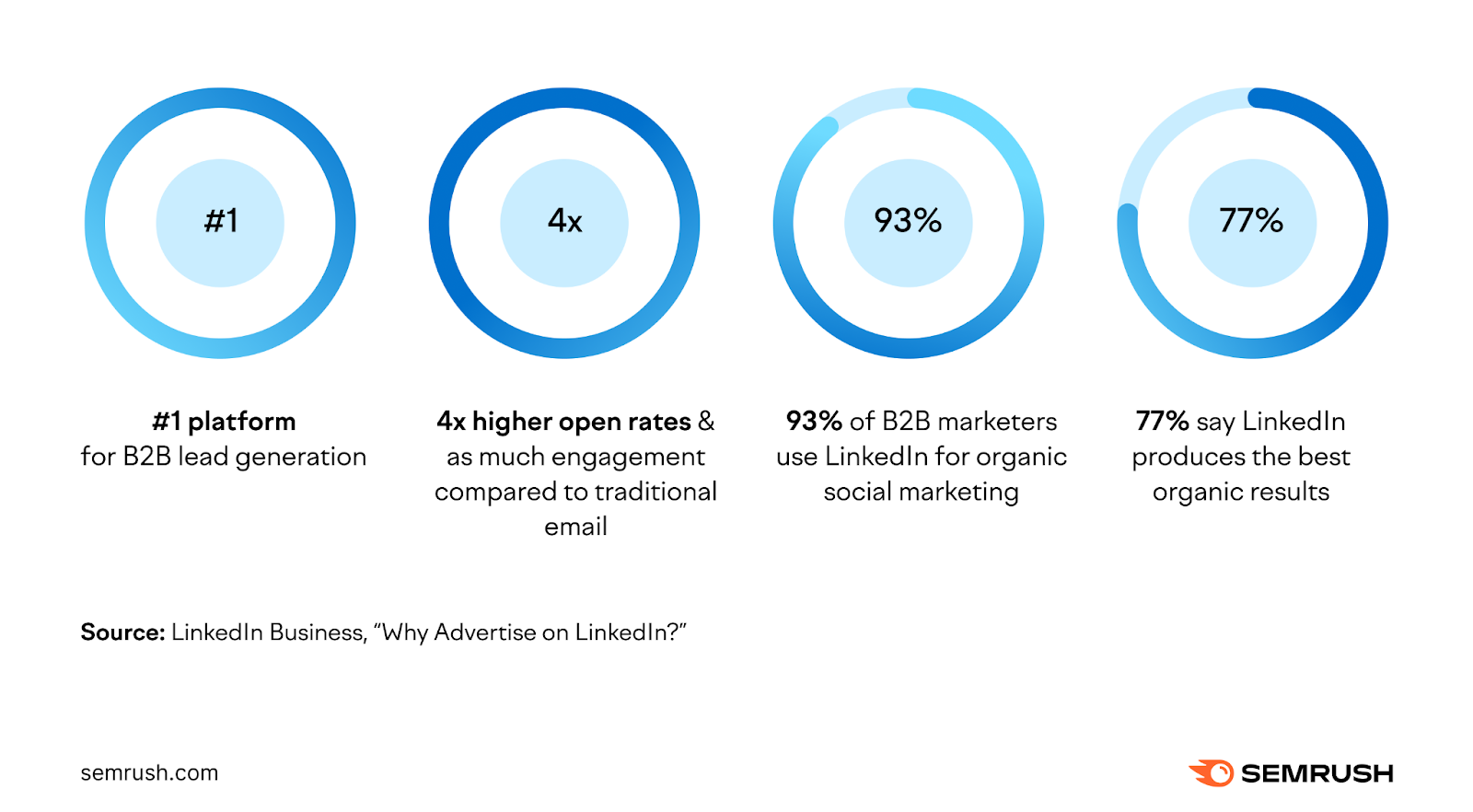
Having a strong presence on the platform means you can directly engage with decision-makers and influencers in your industry.
Plus, LinkedIn users have twice the buying power of the average web audience. And audiences on LinkedIn are six times more likely to convert, according to LinkedIn.
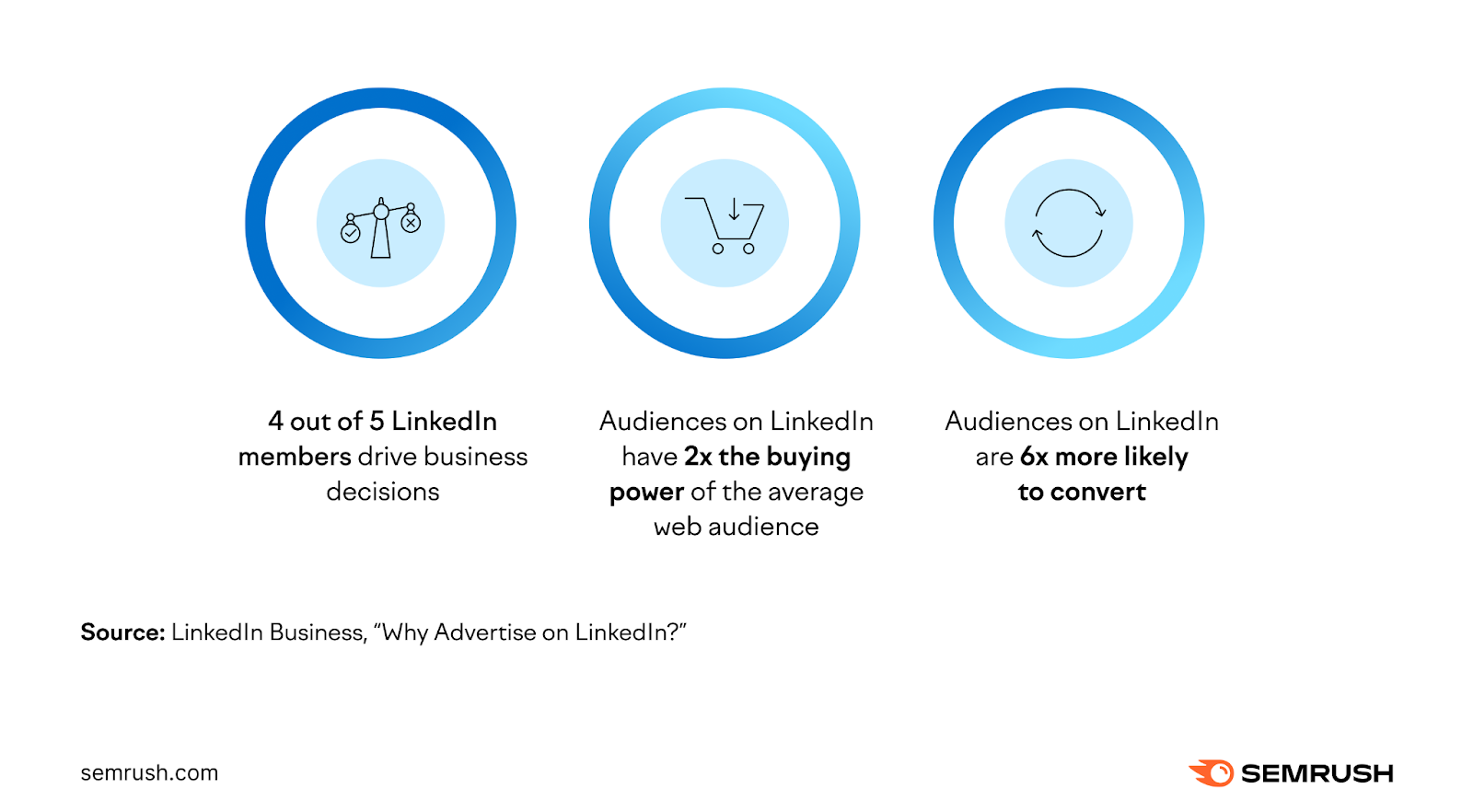
Tips for Business LinkedIn Marketing
Whether you want to attract top talent, generate new leads, boost website traffic, or all three, LinkedIn can help.
Here are some top tips on how to use LinkedIn for business marketing:
Know Your Audience
Some of the first questions you should answer when drafting your LinkedIn marketing plan are:
- Who is my company’s ideal customer?
- Who do I need to target to generate leads and conversions on LinkedIn?
- What type of content will attract my ideal audience?
Knowing your audience sets the foundation for your LinkedIn B2B marketing strategy. It ensures your content and engagement strategies are targeted to the right people.
It also helps you craft messages that resonate, which can lead to higher engagement, stronger leads, and better conversions.
Here’s how you can get to know your LinkedIn audience:
- Analyze customer profiles: Look at current customer profiles and see what common characteristics they share. Identify patterns in industries, job roles, challenges, and solutions.
- Join LinkedIn groups: Join LinkedIn groups where your target audience is active. Observe discussions, questions, and feedback. This can provide valuable insights into their needs and preferences. Use the information to tailor your content and language to your target market.
- Post polls: Use polls on LinkedIn to ask questions on the type of content your audience wants to see.
- Use Social Analytics: If you already have a business page, use Semrush’s Social Analytics tool to get more insight into your audience’s locations, industries, job functions, interests, and more.
Once you’re clear on your ideal followers, update your LinkedIn profile to attract them.
For example, here’s how we attract our ideal customer with our LinkedIn headline and “About” section:
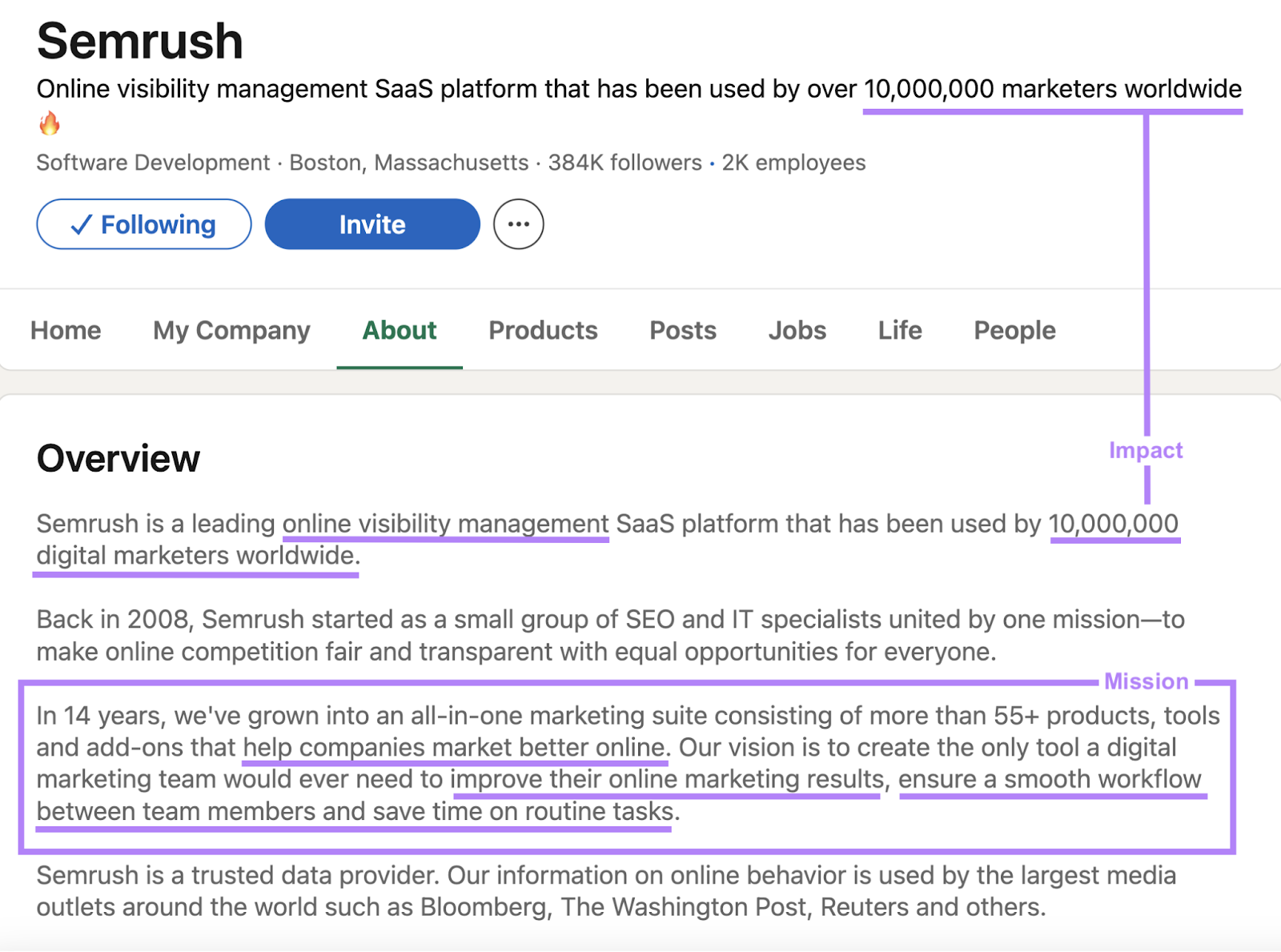
We used concrete data, like “10,000,000 digital marketers,” to make an impact. And we clarified our primary mission in the About section: “help companies market better online.”
Study Competitors with a Strong LinkedIn Presence
Understanding what’s working for similar businesses gives you a real sense of what might work for you, too.
Before you start posting, research your competitors’ LinkedIn presence.
Here’s how:
- Analyze competitor LinkedIn profiles to understand their branding and positioning
- Examine their content strategies, noting the types of posts, frequency, and engagement levels
- Observe how competitors engage with their audience through comments and messages
- Analyze the demographics of your competitors’ followers
- Review competitor job postings to gain insights into growth opportunities and company culture
- Analyze the use of keywords and hashtags in competitors’ posts
- Attend webinars or live events hosted by competitors to gauge their thought leadership and community engagement
Once you’ve analyzed your competitors, consider how to use the information to inspire your presence on the platform. Maybe you notice a content gap or think of a different angle on a popular topic.
This information will help you tailor your content production. For example, let’s say you run a digital marketing agency and notice a competitor frequently gets a lot of engagement on their short videos about SEO best practices.
However, they rarely discuss social media strategies, an area you have considerable experience in. Use this information to produce a series of short videos focused on social media tips, filling the gaps left by your competitor.
Use a Content Calendar to Ensure Consistency
Companies that share content weekly tend to double their audience engagement, according to LinkedIn.
By regularly appearing in your audience’s feed, you remind them of your expertise and services. So they’re more likely to think of you when they need the type of product or solution you offer.
One way to stay consistent is to use a content calendar.
You can use our Social Poster tool to draft, schedule, and post content across multiple social media platforms, including LinkedIn.
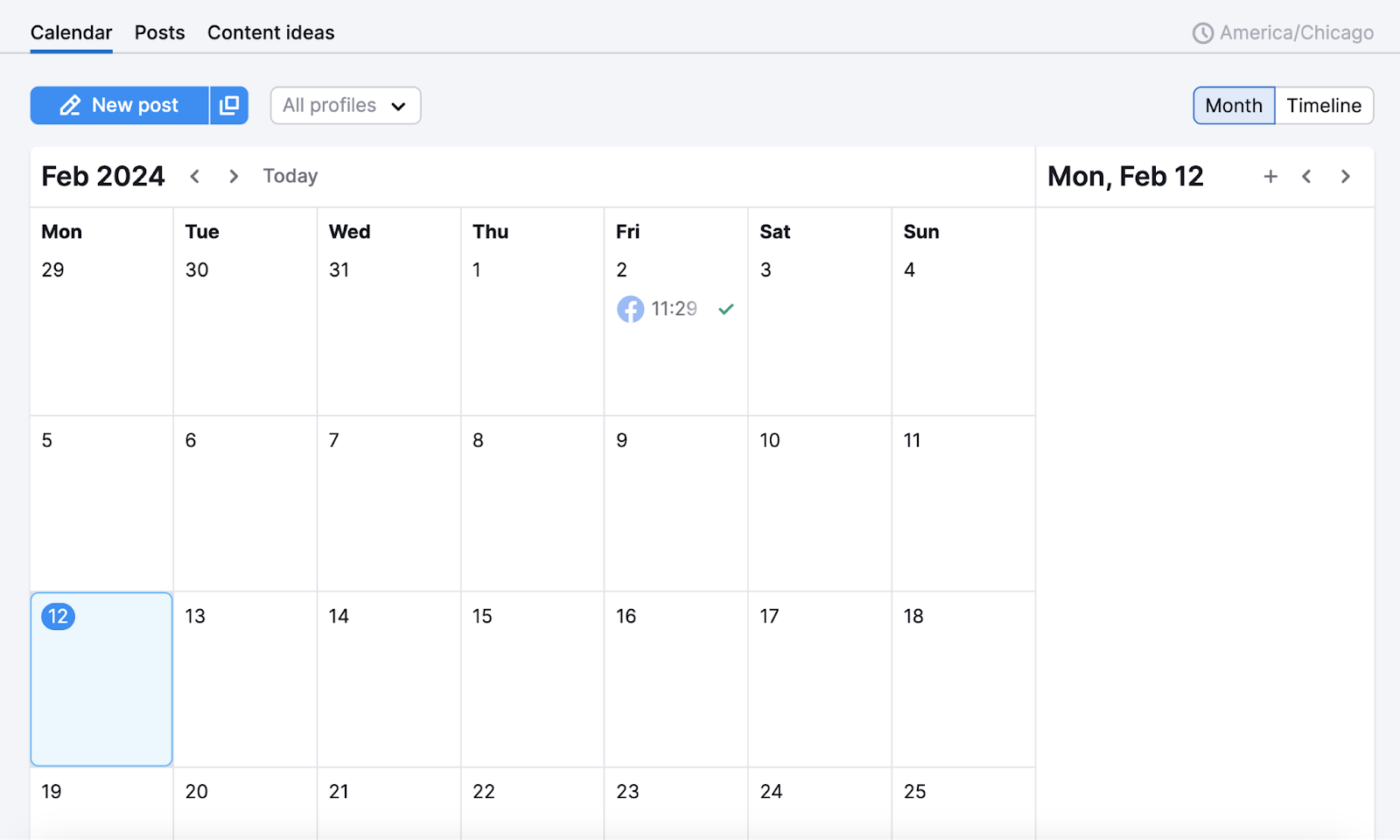
You can also monitor engagement and followers and get insights into the best times to post. This way, you keep your brand in front of your audience when they’re most active.
Open the Social Poster tool and select “Add Profile” to get started.
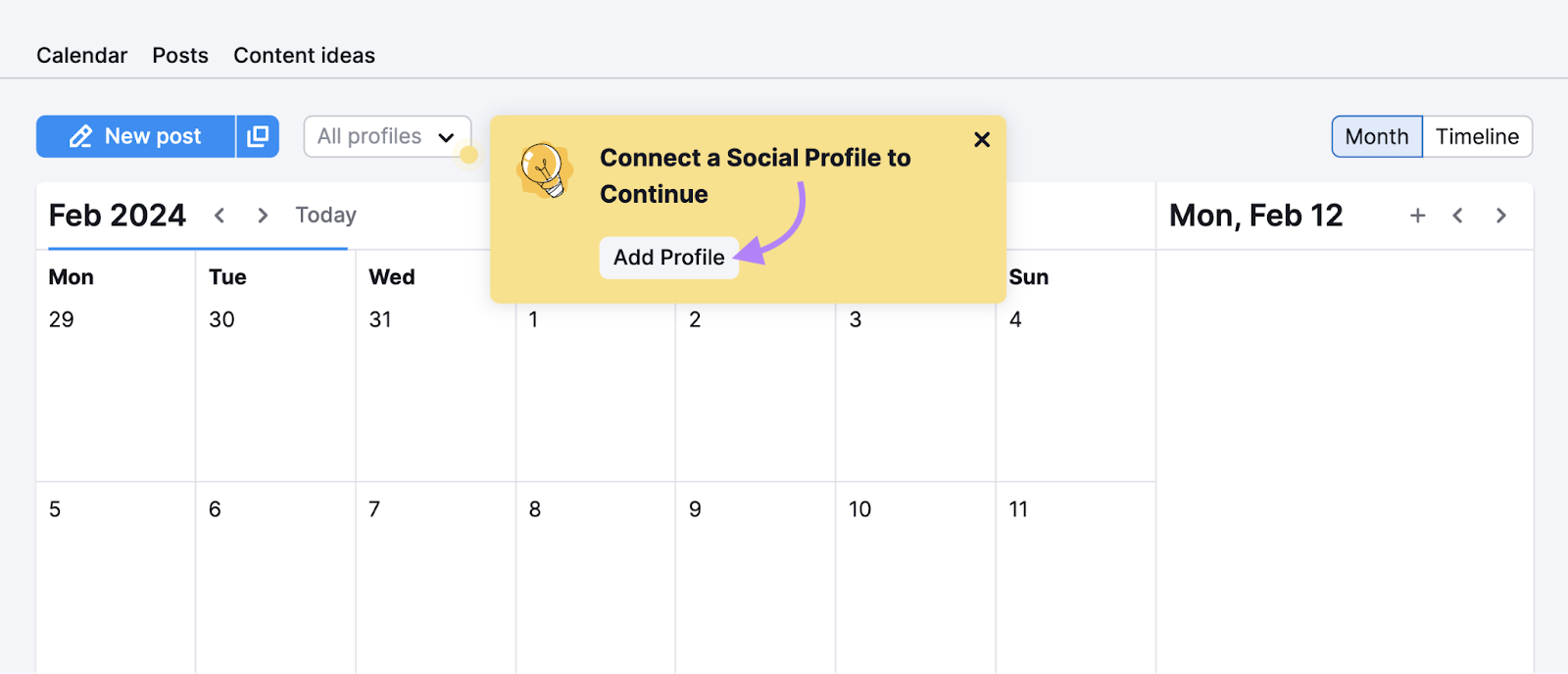
Select “LinkedIn” from the list.
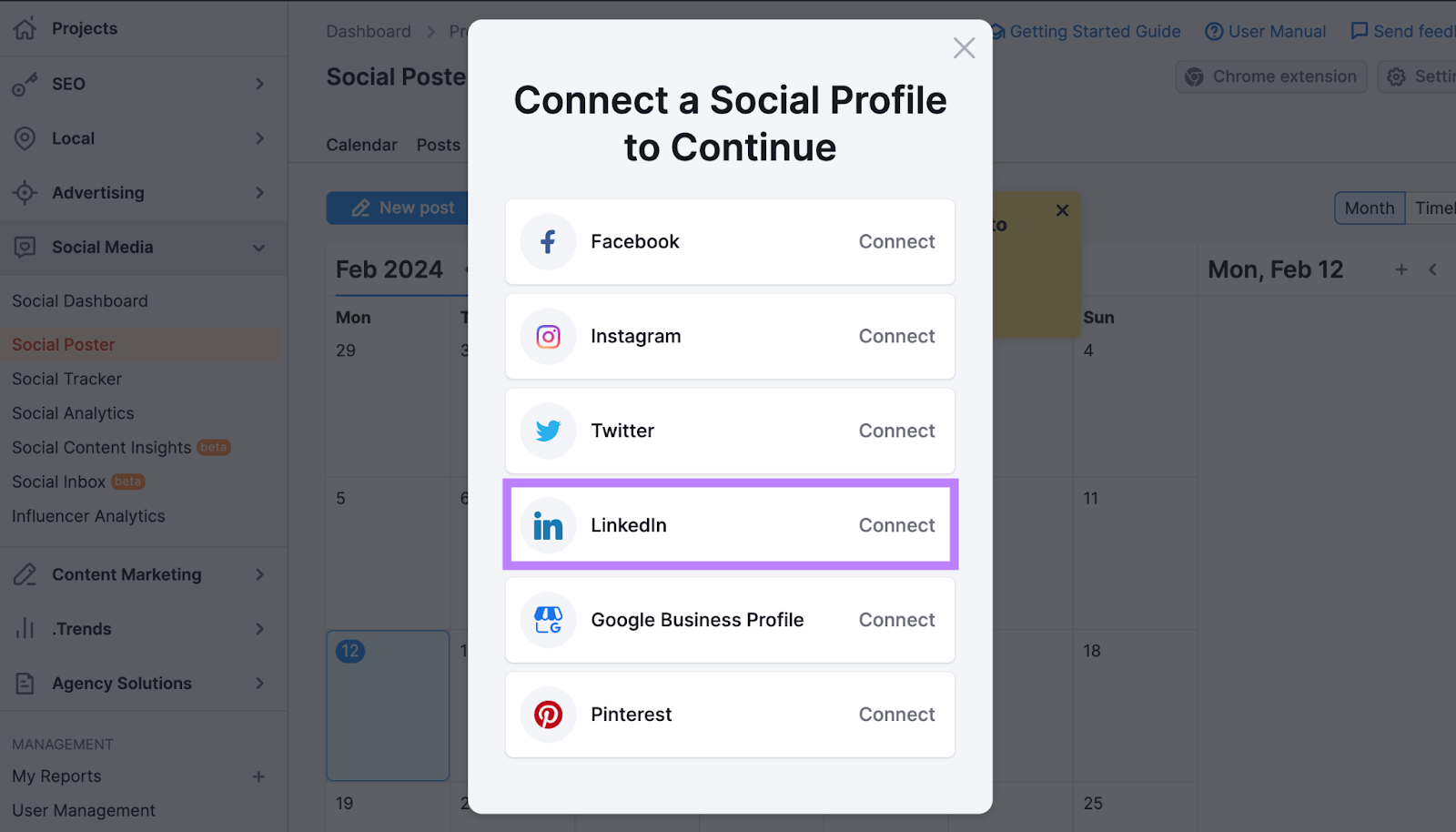
Next, check the box next to your business page and click “Add profiles.”
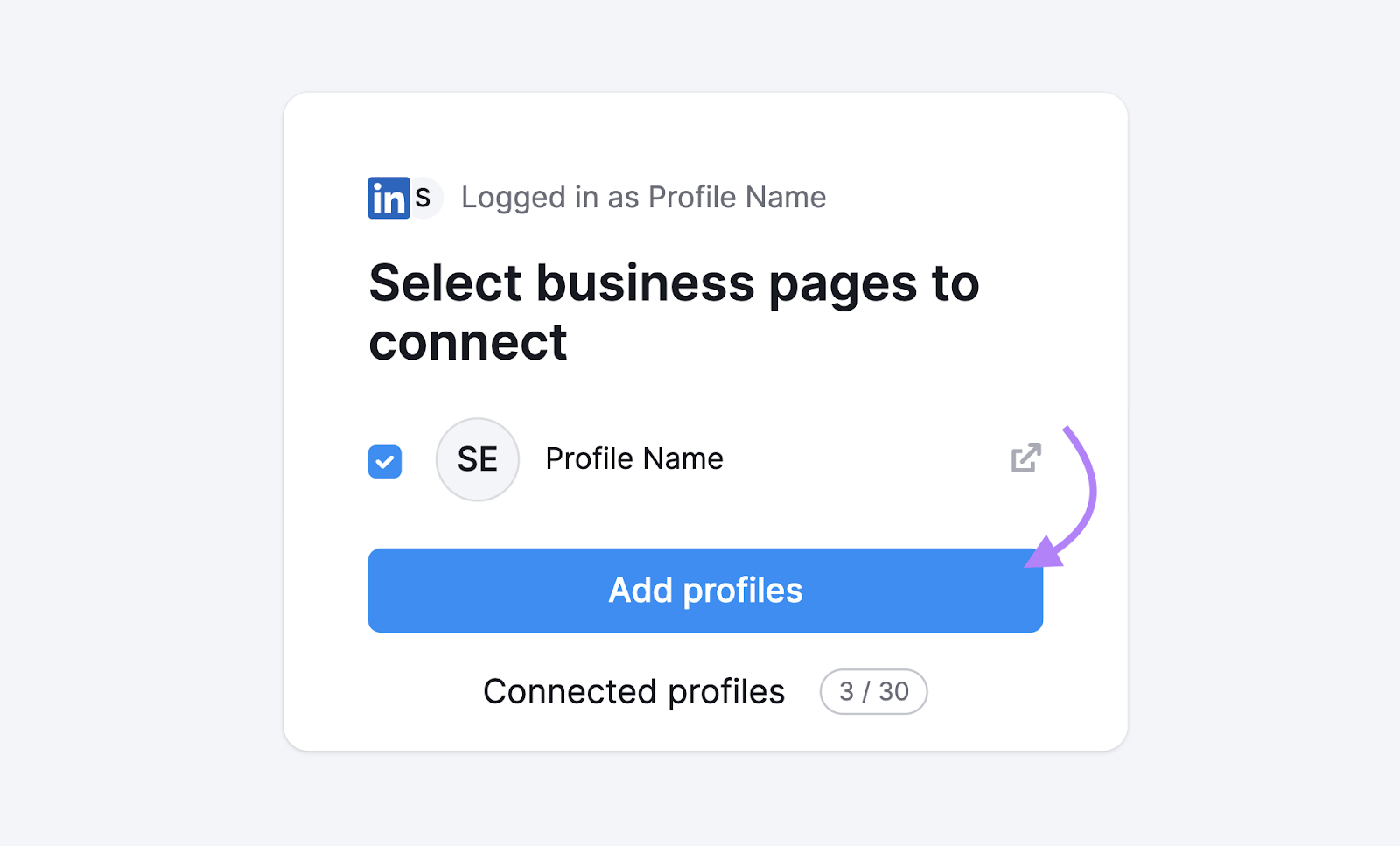
Once you’re set up, you’ll automatically be taken to the “Calendar” tab. Here’s where you’ll see all the posts scheduled to go out within a certain month.
To draft and schedule a new post, click the “New post” button at the top left of the calendar.
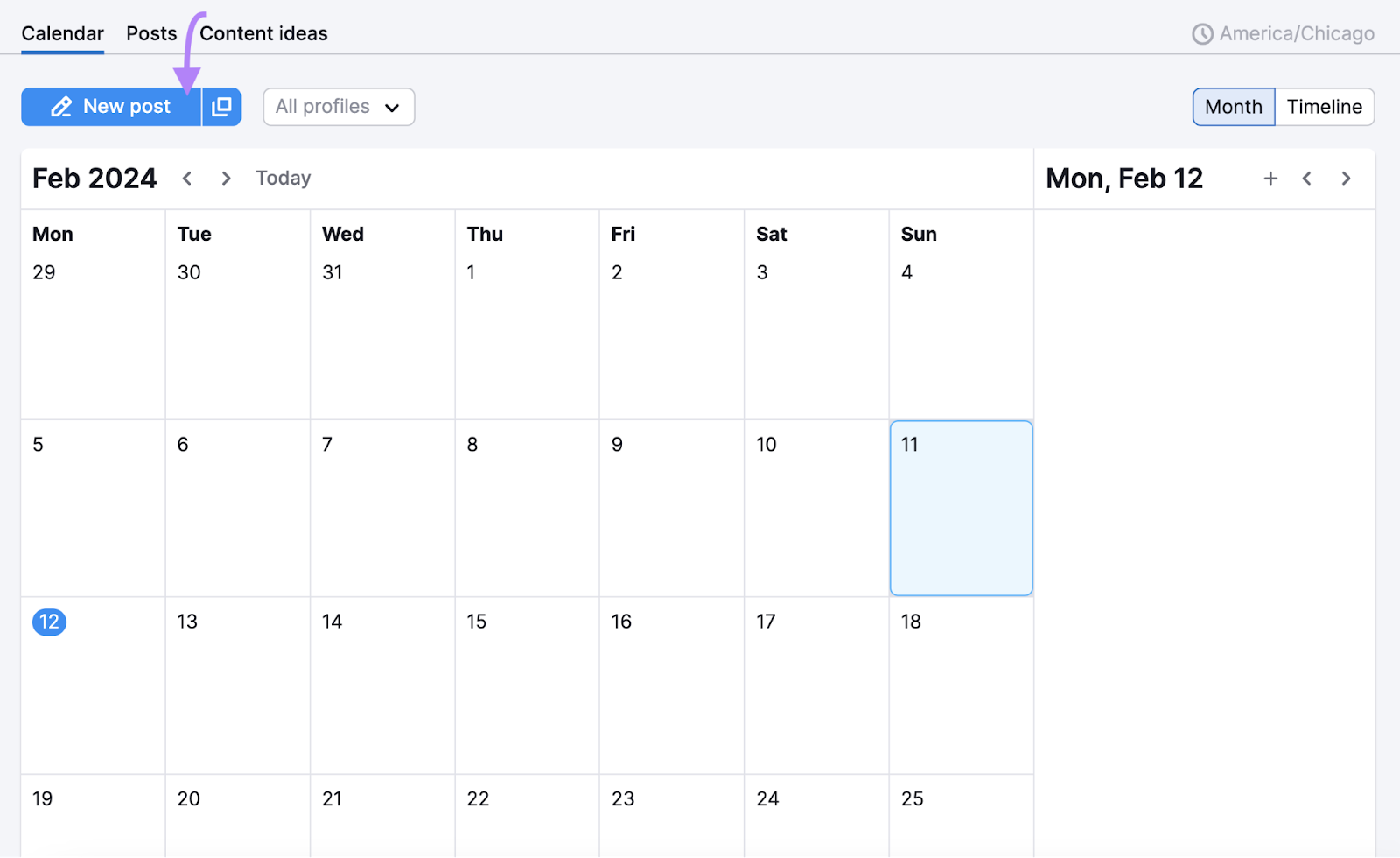
On the right-hand side, you’ll see a preview of how your post will look when it’s posted.
Post your content immediately, schedule it for another time. Or save it as a draft.
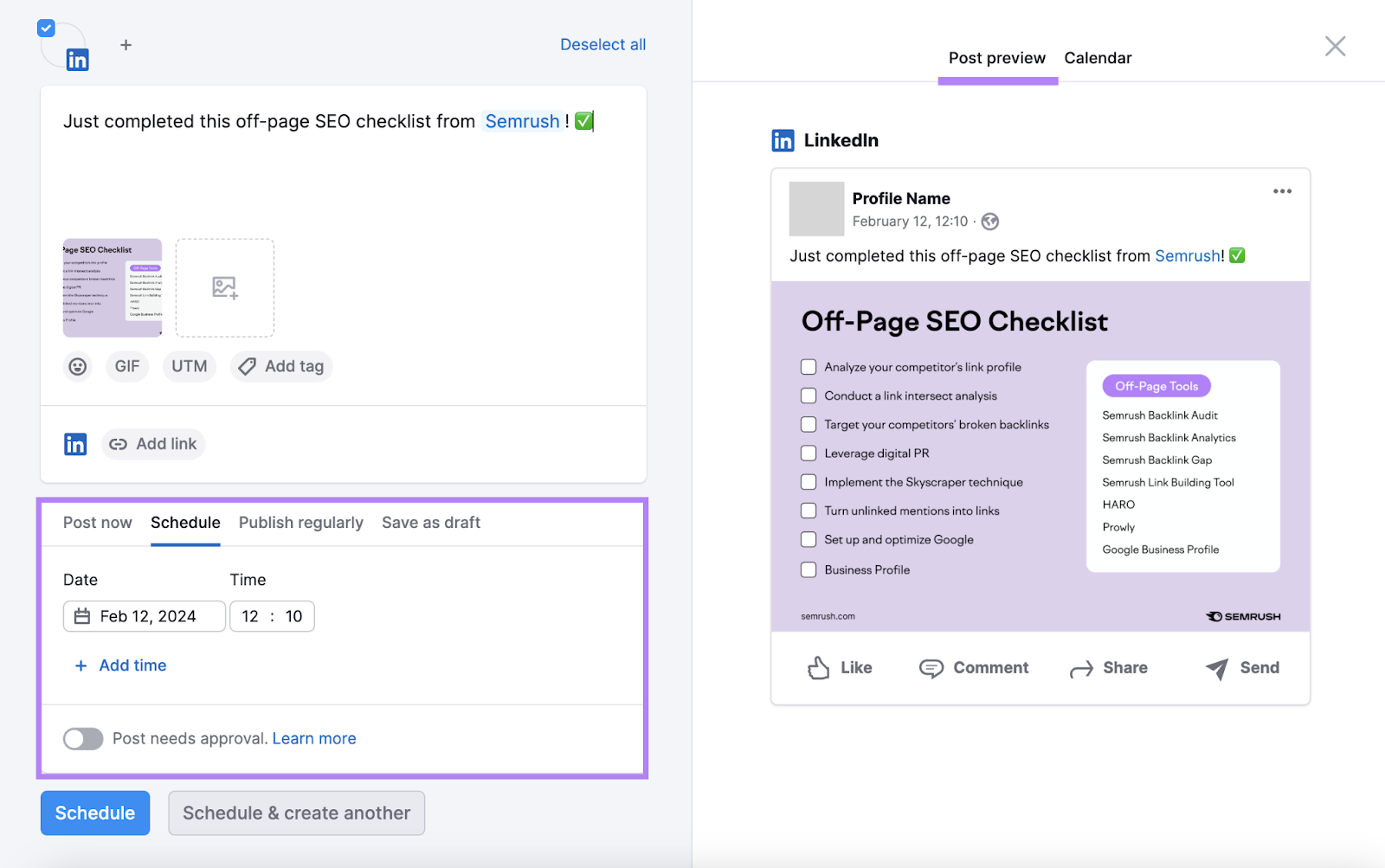
In the “Posts” tab, you can also find every piece of content you’ve previously shared, scheduled, or drafted. Along with their most important metrics at a glance, including views, likes, and reposts.
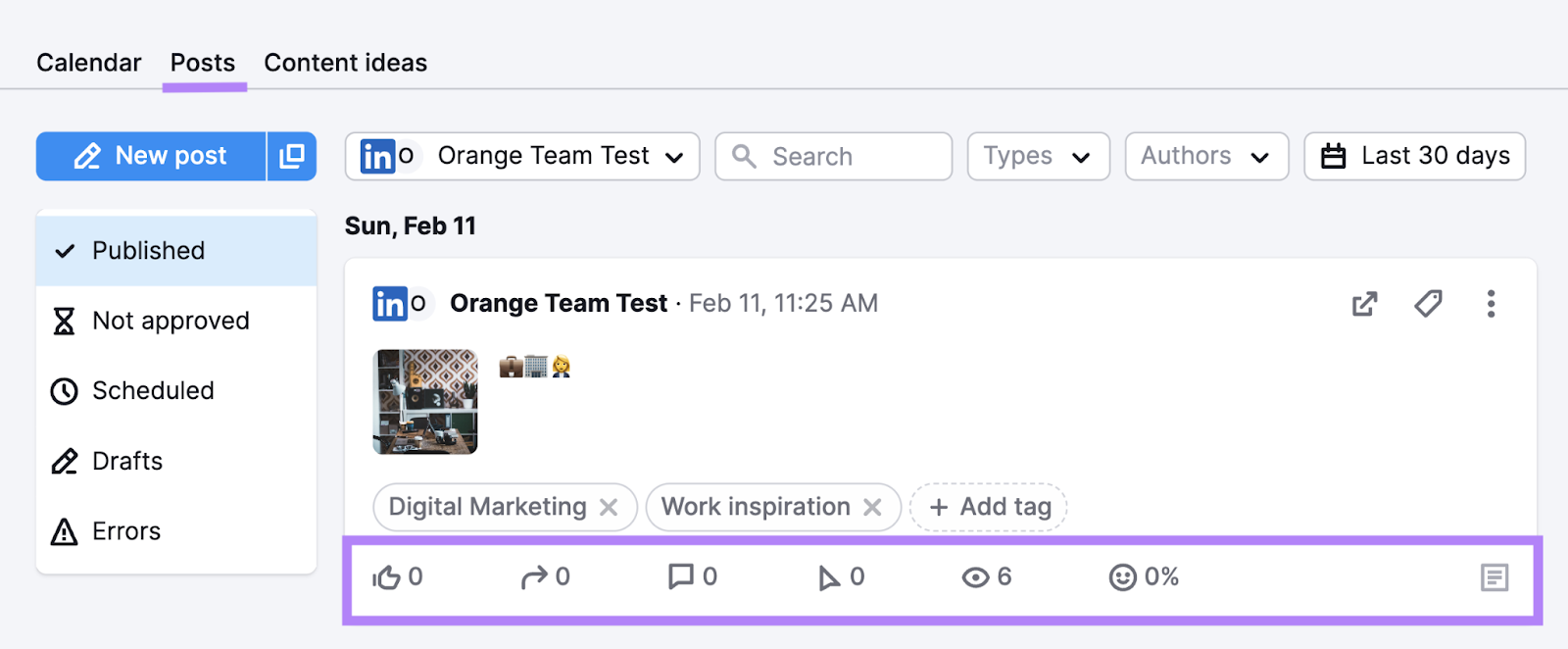
Engage Your Audience Regularly
Engaging with your audience on LinkedIn helps you build a strong community and turn followers into loyal brand advocates.
LinkedIn’s algorithm also favors posts with higher engagement. So, regularly interacting with your followers can increase the visibility of your content.
You can do this in the following ways:
Prioritize acknowledging and interacting with comments on your posts. This shows your audience their opinions are valued and encourages more engagement, making your brand feel more accessible and personable.
For example, we frequently engage our audience by replying to comments in a friendly and helpful tone and asking commenters for their feedback.
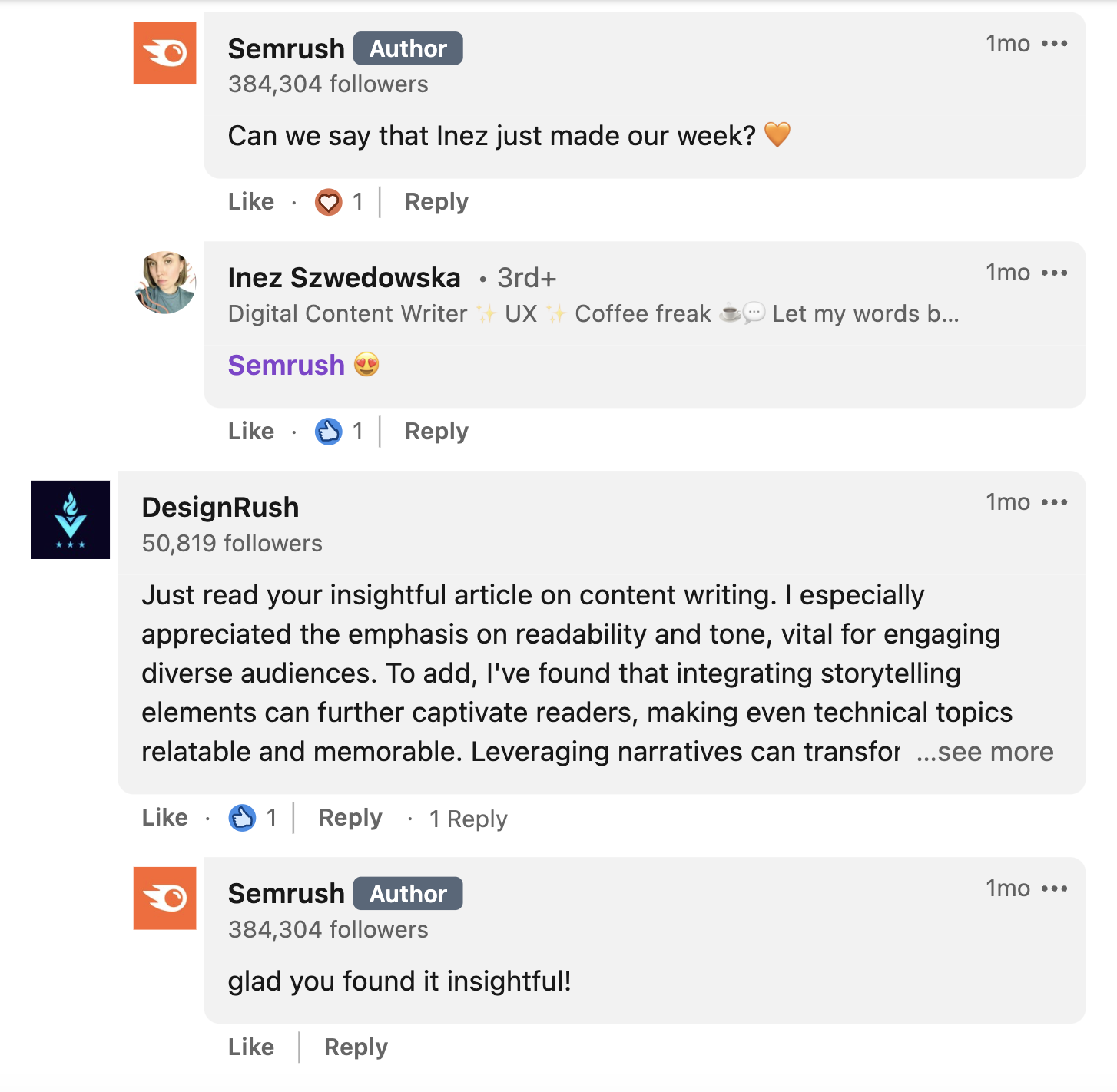
Post Interactive Content
Use polls, open-ended questions, or content that asks for opinions to spark conversations. This not only increases engagement but also gives you insights into what your audience thinks and prefers.
In this example, Asana directly asks their audience about the importance of collaboration technology:
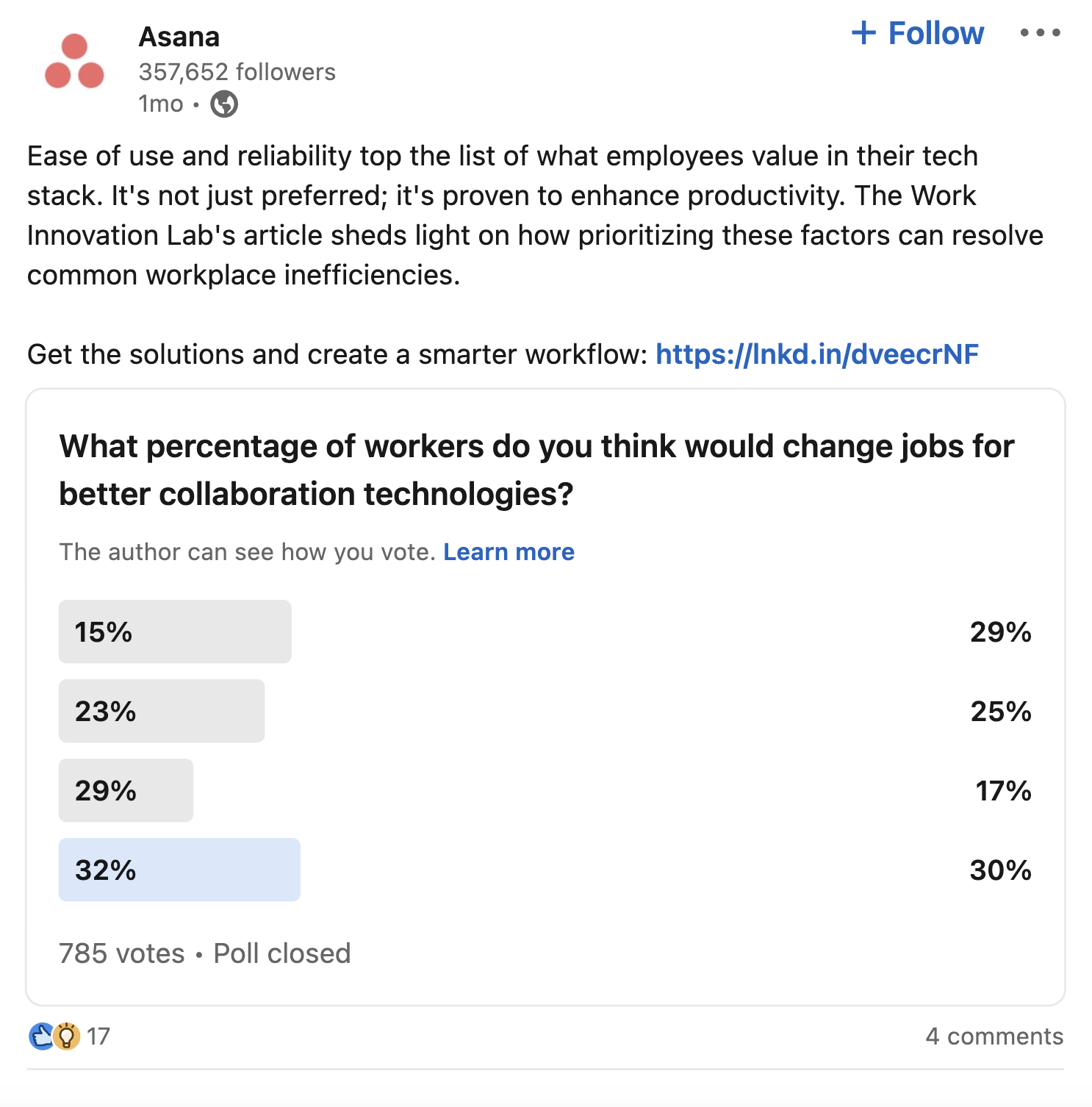
Highlight Customer Stories and Testimonials
Share stories, testimonials, or case studies from your customers. This provides social proof and engages your audience by putting the spotlight on them, making them feel like they’re a part of your brand’s community.
Here’s an example from Zapier that breaks down exactly how a user was able to improve conversions and increase sales by using the tool:
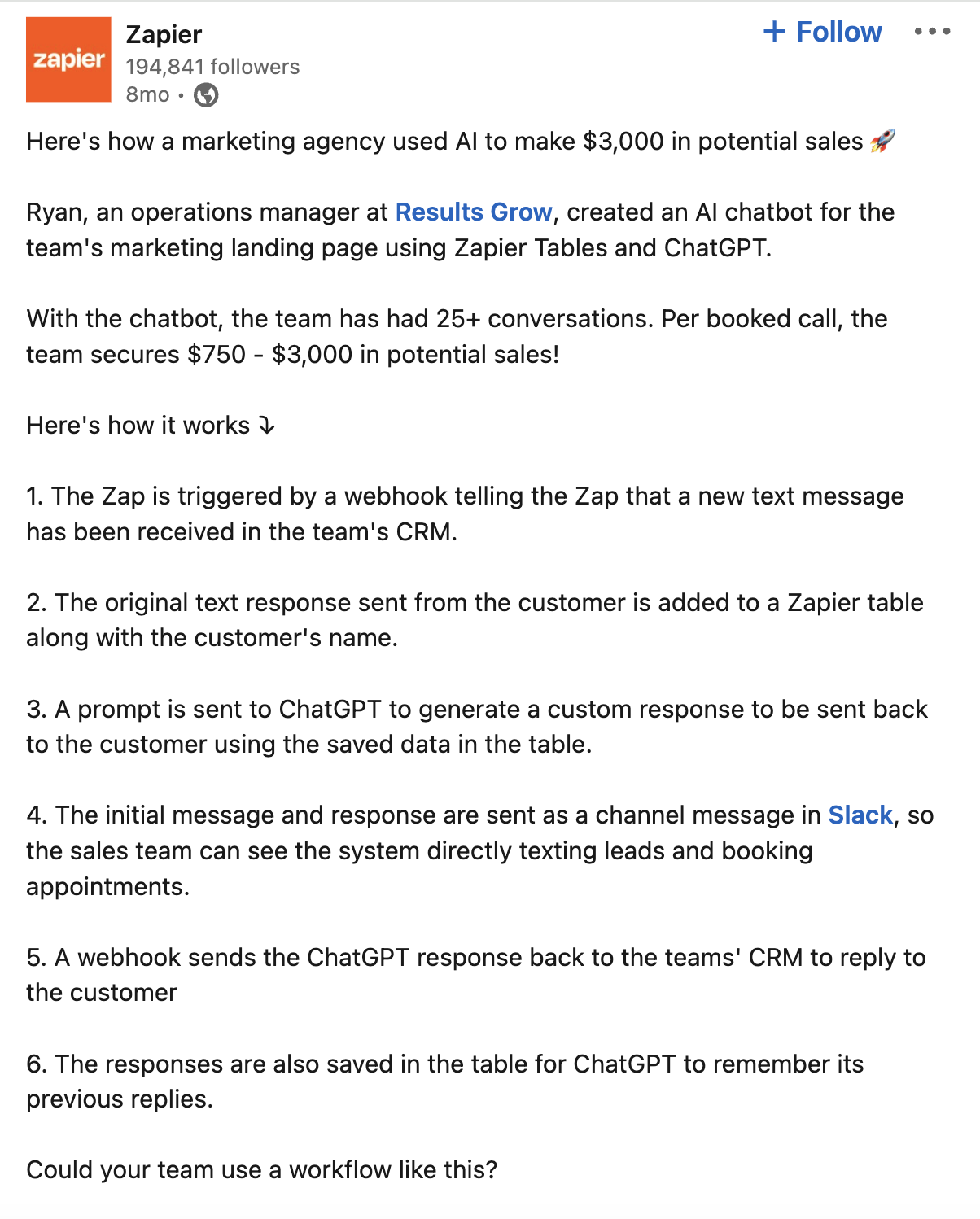
This not only helps users feel like a community but shows Zapier’s audience the results they could achieve with its tool and how.
Advertise Company Wins
Posting about achievements helps demonstrate your expertise and reliability in your industry.
It also builds trust among your audience and helps make potential clients and partners more confident in choosing your services or products.
As a bonus, showcasing your company’s growth and success can also make you more attractive to top talent.
Why?
Because people may be more motivated to work for companies that are recognized as industry leaders and innovators.
Here are some ideas of achievements you can celebrate on LinkedIn:
- Awards
- Milestones reached
- Successful project completions
- Positive media mentions
- Significant new partnerships
- Launching a new product
For example, software company TestGorilla shared the achievement of receiving more than 1,000 verified reviews about their product on LinkedIn:
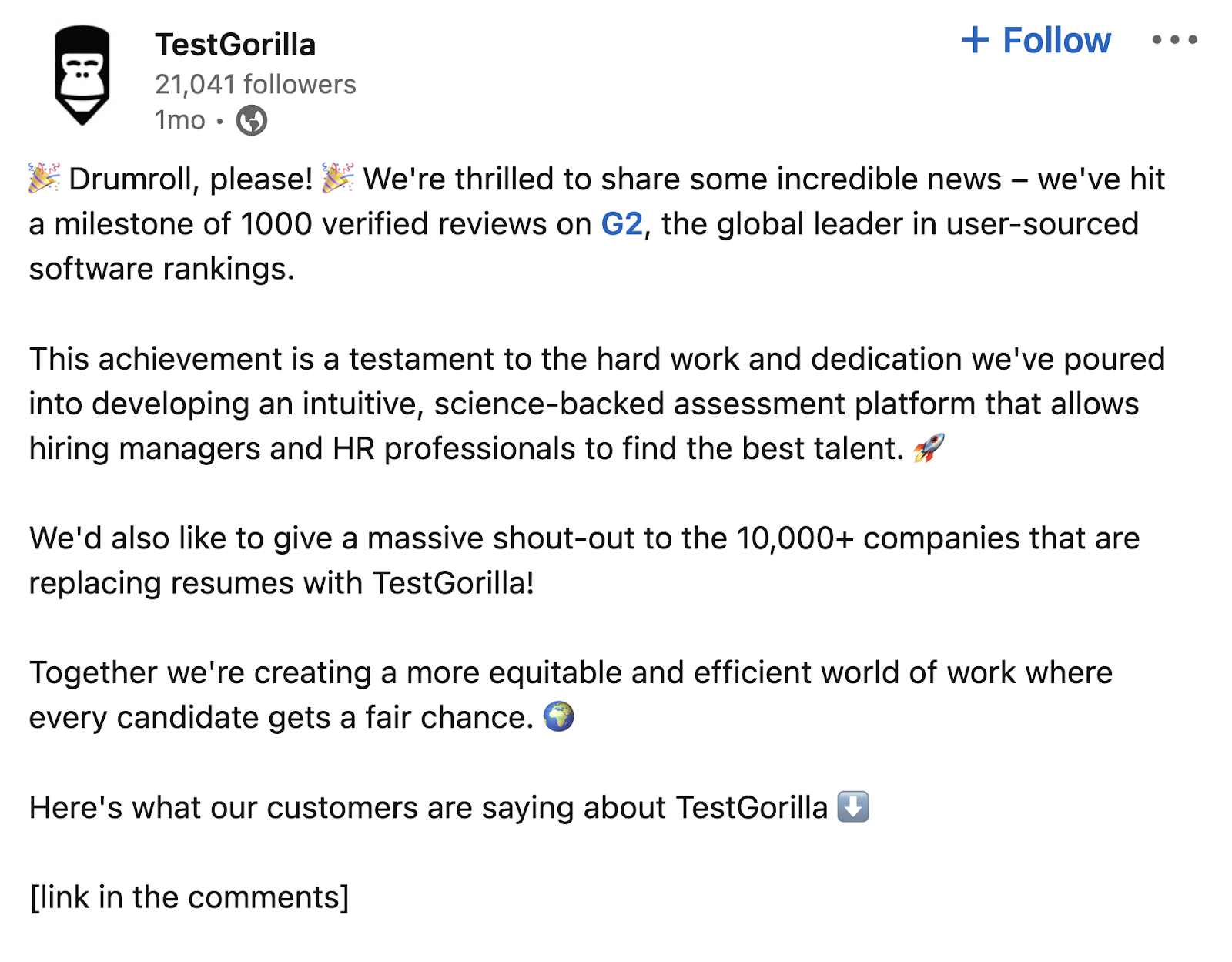
Remember, these posts aren’t just news—they’re proof of your company’s ability to deliver results.
Empower Employees to Get Active on LinkedIn
When your team is active on LinkedIn and shares content about their experience with your company, it can feel more genuine and relatable.
Here are some ways to leverage employees’ profiles for your LinkedIn business marketing strategy:
- Launch an employee advocacy program and encourage people to share and engage with company content on their personal profiles
- Support and motivate employees to post their own professional insights and experiences related to your industry. When employees are seen as experts, it reflects positively on the company’s reputation.
- Encourage employees to share behind-the-scenes glimpses of their work life, company events, or achievements. This type of relatable content can humanize the brand.
- Ask team members to list your company as their workplace on their personal pages and follow your company profile
- Involve employees in creating content. For example, hosting Q&A sessions, interviews, or panel discussions on industry topics on their profiles can attract diverse audiences.
Udi Ledergor, chief evangelist at revenue intelligence platform Gong, a revenue intelligence platform, is a great example of an employee who uses their personal profile to promote their employer.
Here, Ledergor explains the importance of employee engagement and how they make it easy for employees to share content or company news.
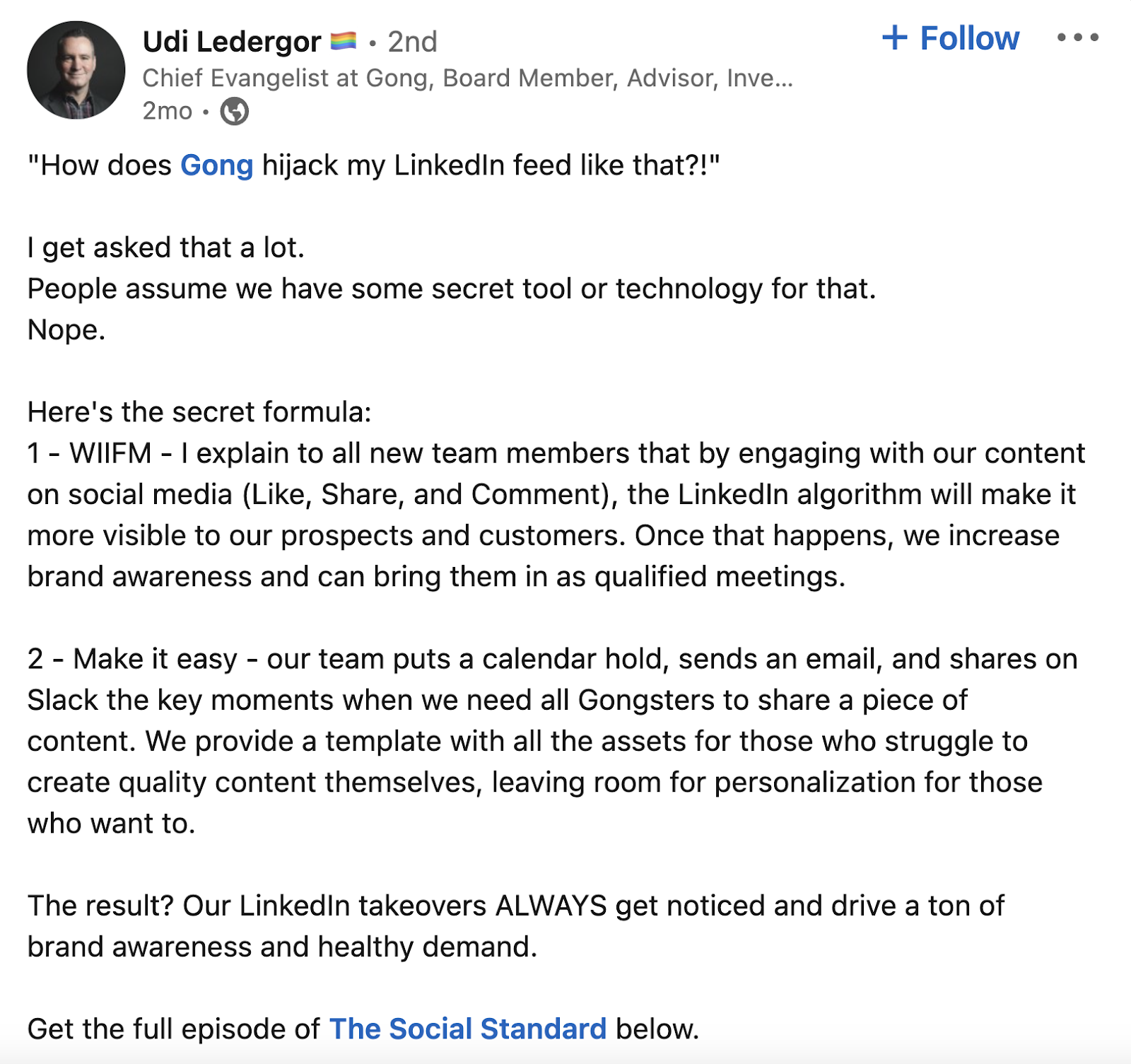
This includes tagging the company’s LinkedIn account in each post, potentially driving more traffic to the business page.
Track Analytics and Refine Your Strategy
Tracking your page’s analytics helps you understand what’s working well and what you can improve.
For a high-level understanding of your page’s analytics, you can use LinkedIn Analytics.
Here, you’ll find general information on metrics like unique visitors, content impressions, followers, and competitors.
For example, if your video content consistently gets a lot of engagement, you’ll know your audience prefers this format. This ensures you invest your time and resources where it counts.
To access your page’s analytics, simply click the page name from “My pages” on the left side of your homepage.
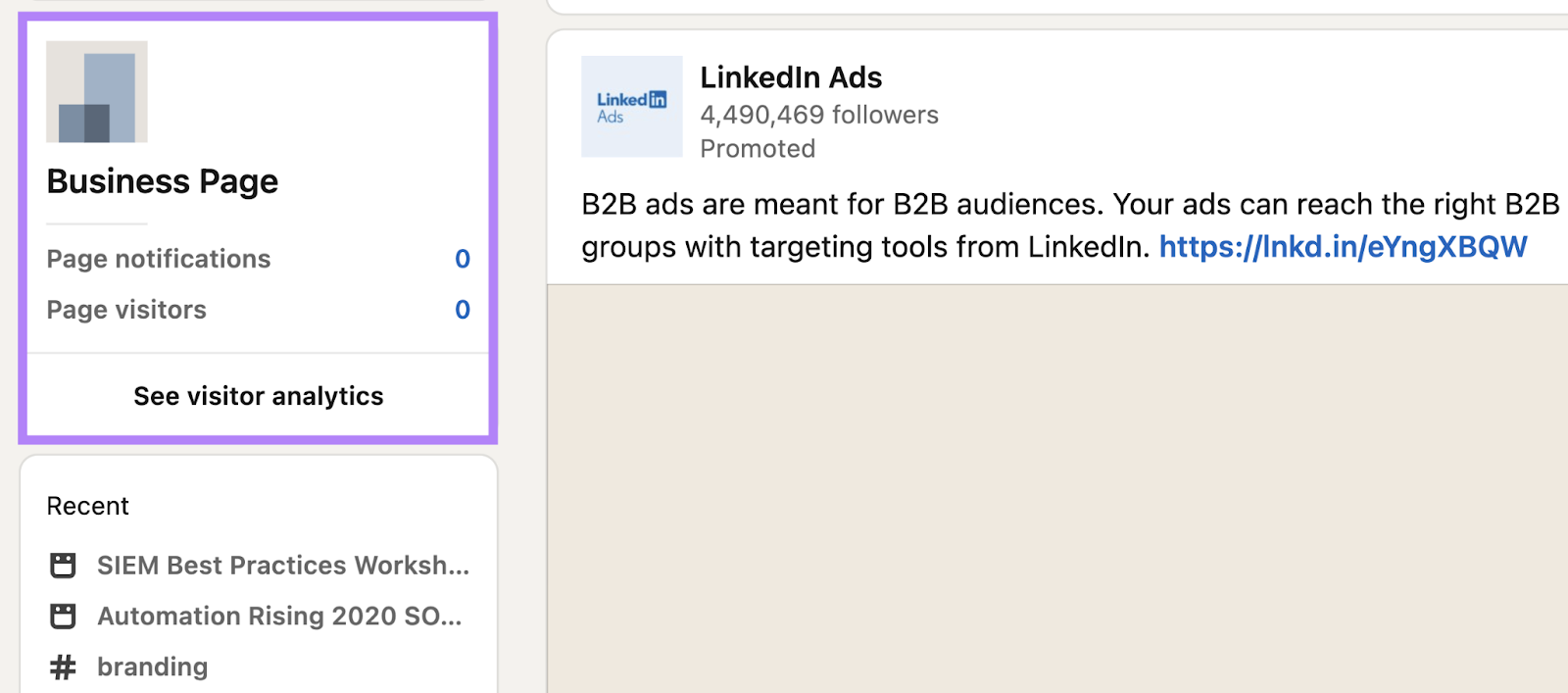
You’ll be taken to your admin view. Next, click the “Analytics” tab at the top of your page. Here, you can choose between metrics on visitors, followers, leads, content, and competitors.
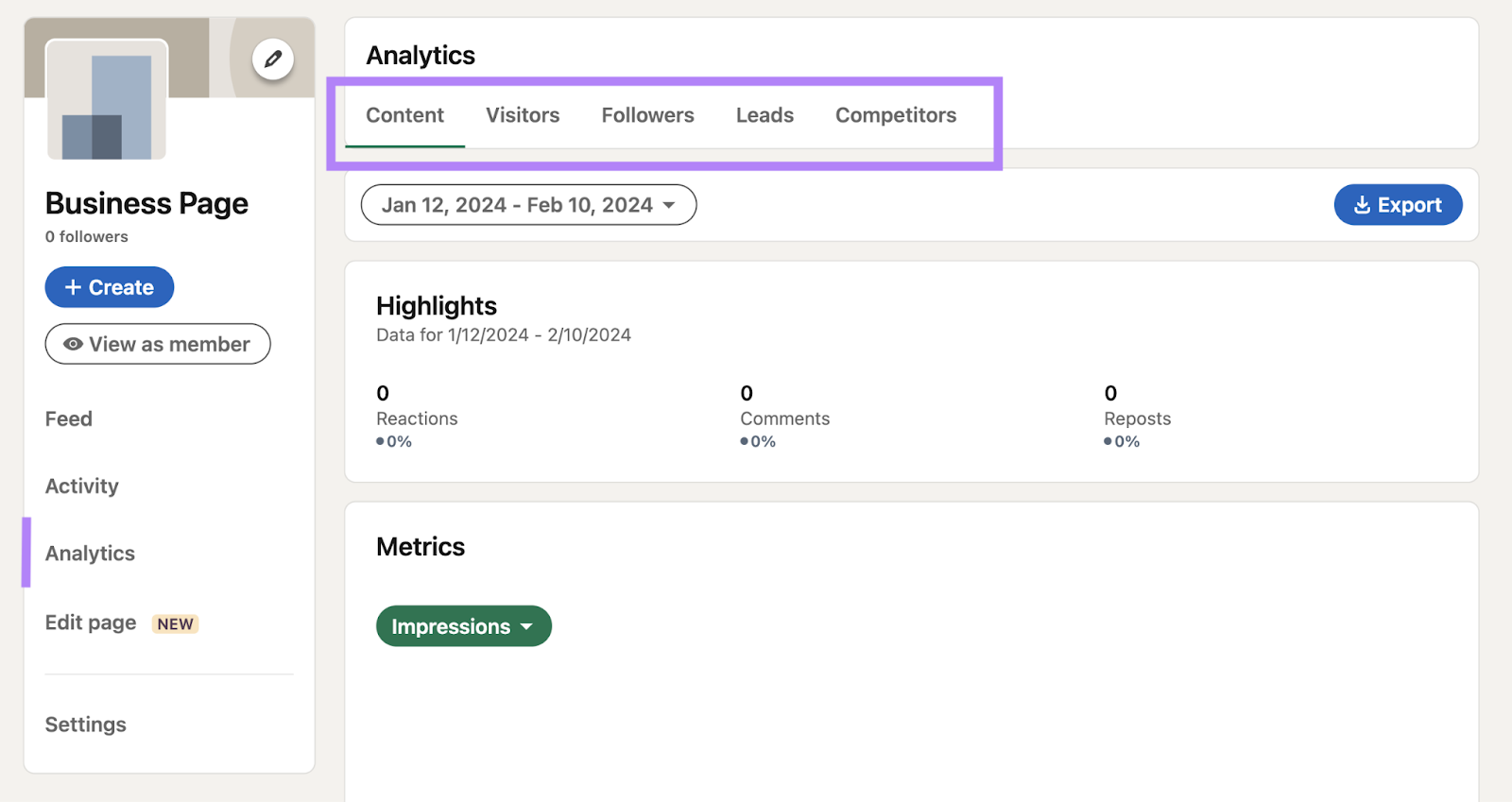
You can also use the Social Analytics tool for a more holistic view of your analytics.
To get started, open the tool and click “Add profile.” From the drop-down menu, select “Connect LinkedIn.”
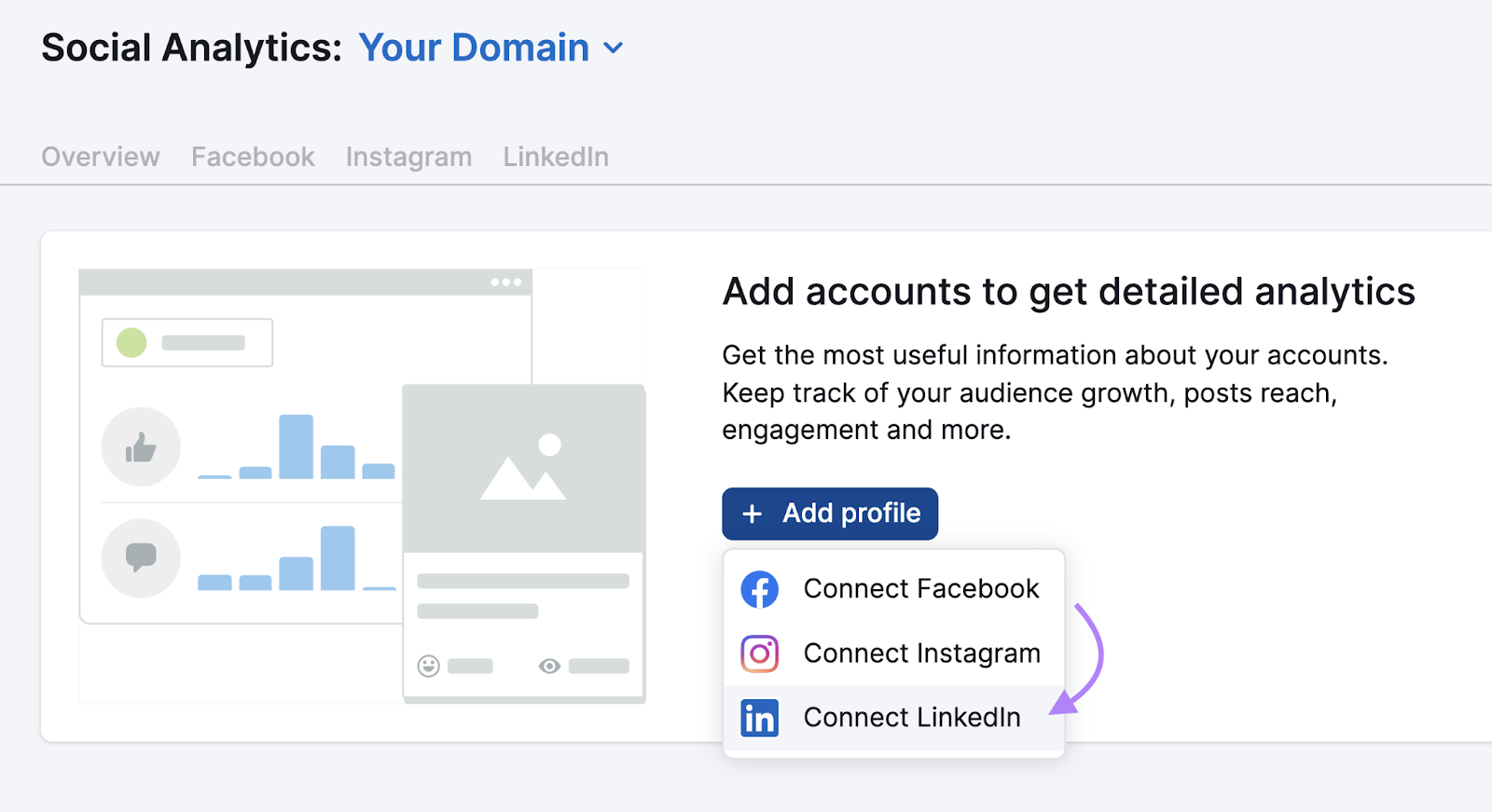
Next, choose the business page you want to connect and click “Add profiles.”
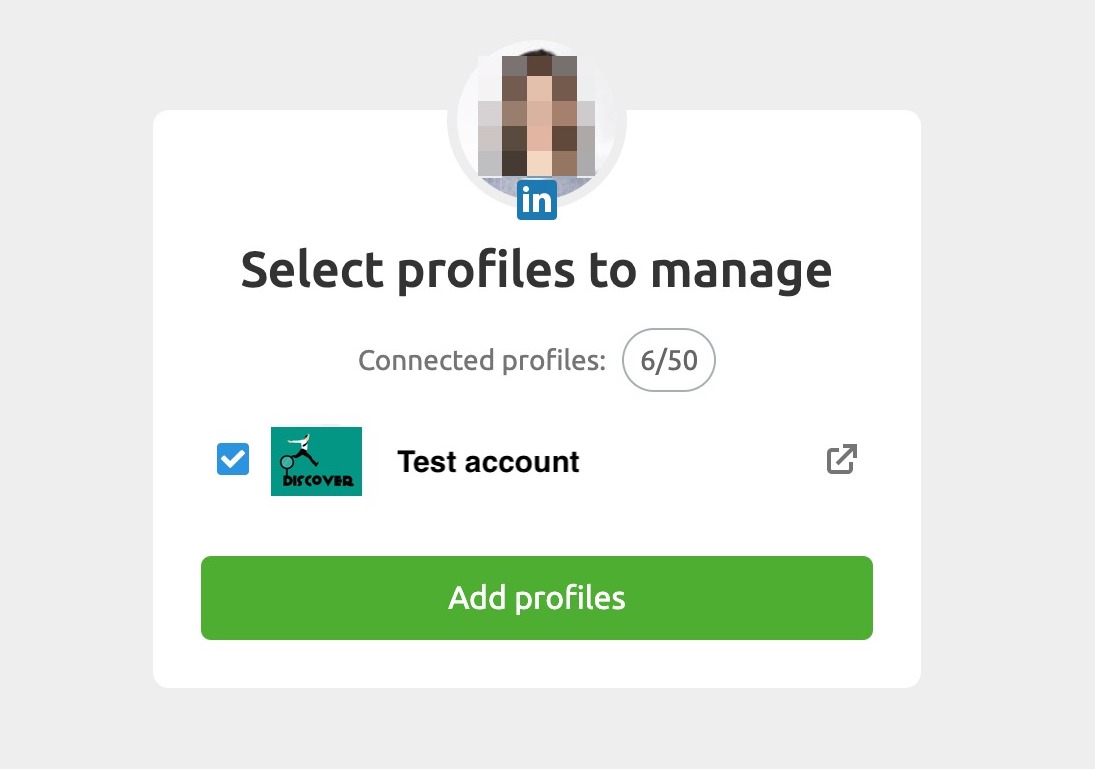
Once you’re set up, navigate to the “LinkedIn” tab of your report.
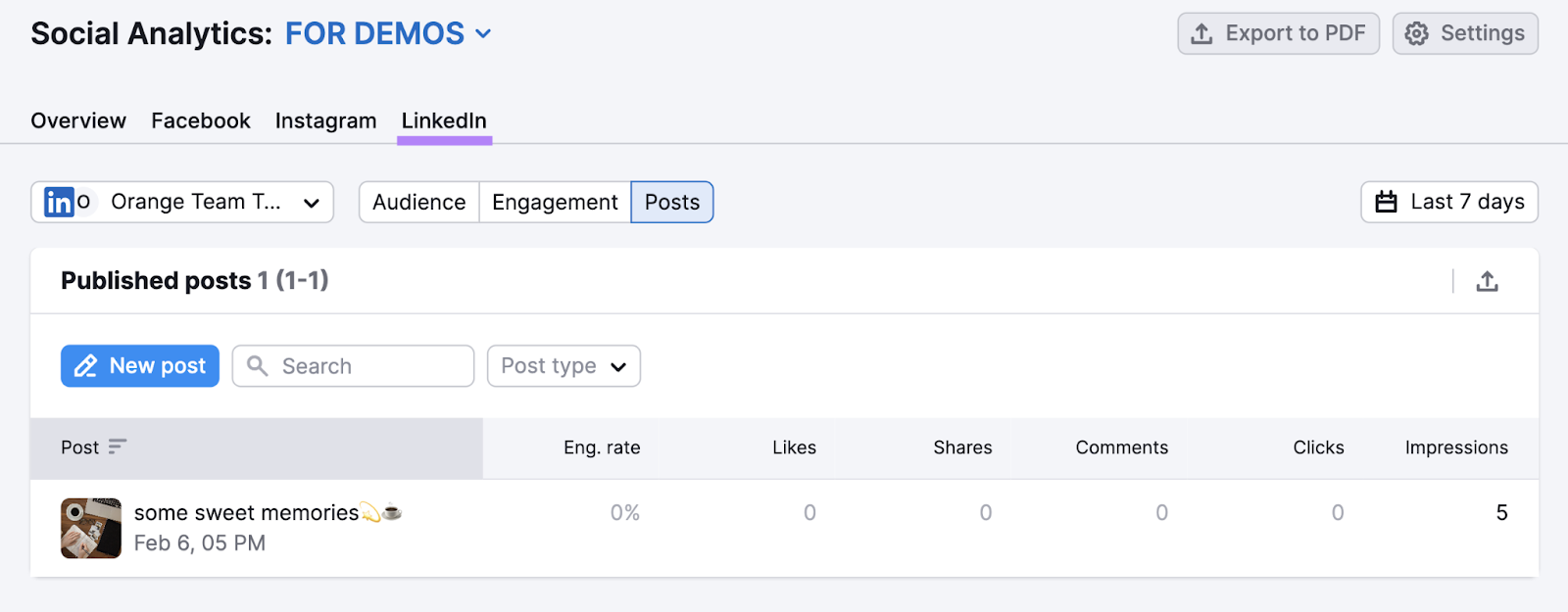
Here, you can toggle between the “Audience,” “Engagement,” and “Posts” tabs to monitor data.
This includes the following:
- Followers’ geographic location
- Followers’ industries and job functions
- The size of followers’ companies
- Total followers
- Impressions and reach
- Engagement rate and average engagement rate growth
- Individual post-performance metrics
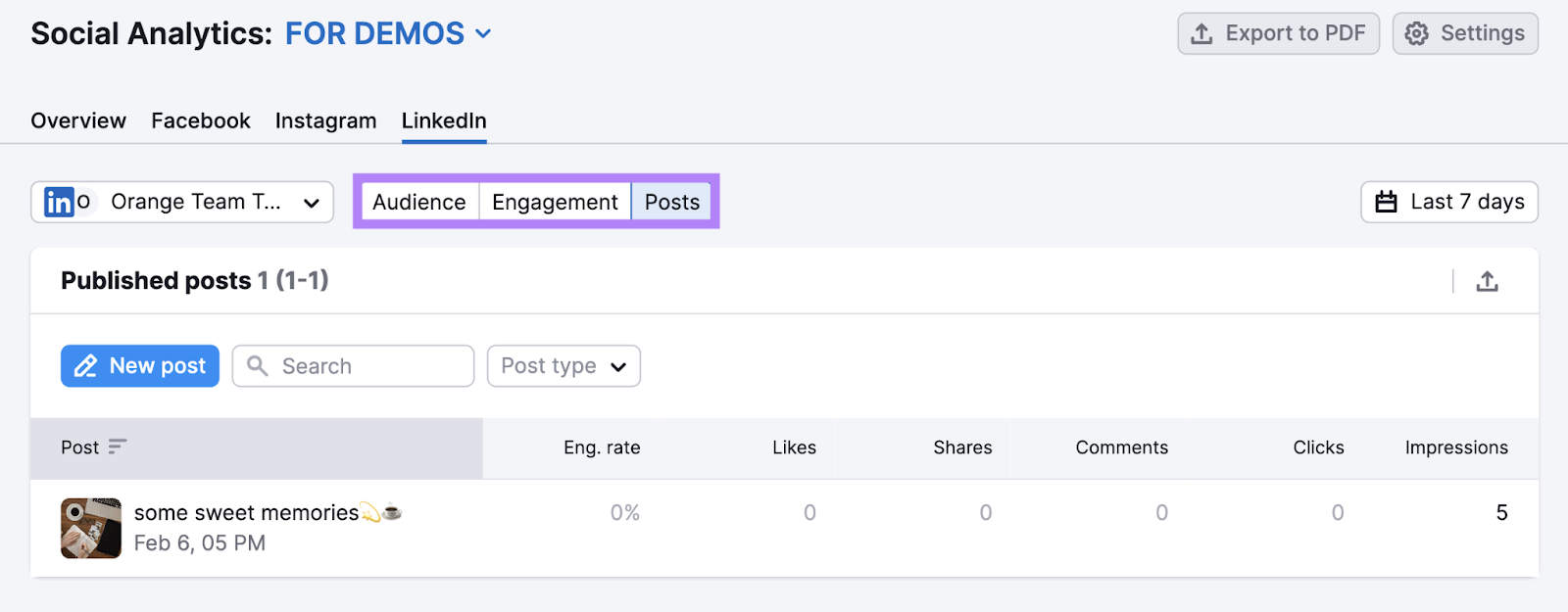
To view historical data, click the “Last # days” button and pick a **** range from the drop-down menu.
This lets you analyze trends and changes over an extended period.
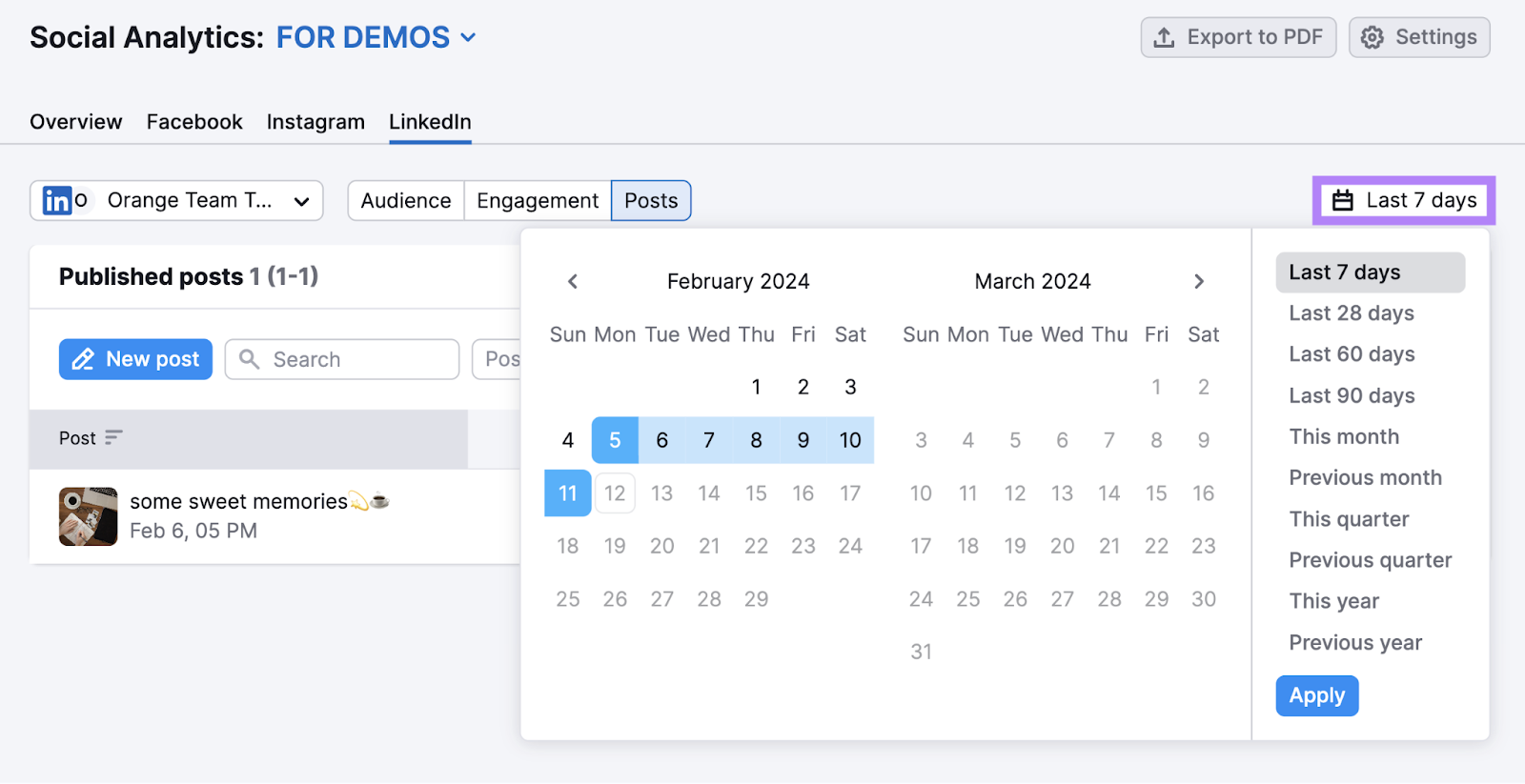
Finally, since Social Analytics is connected to the Social Poster tool, you can create, schedule, publish, and analyze your content all in one place.
All you need to do is navigate to the “Posts” tab and select “New post.”
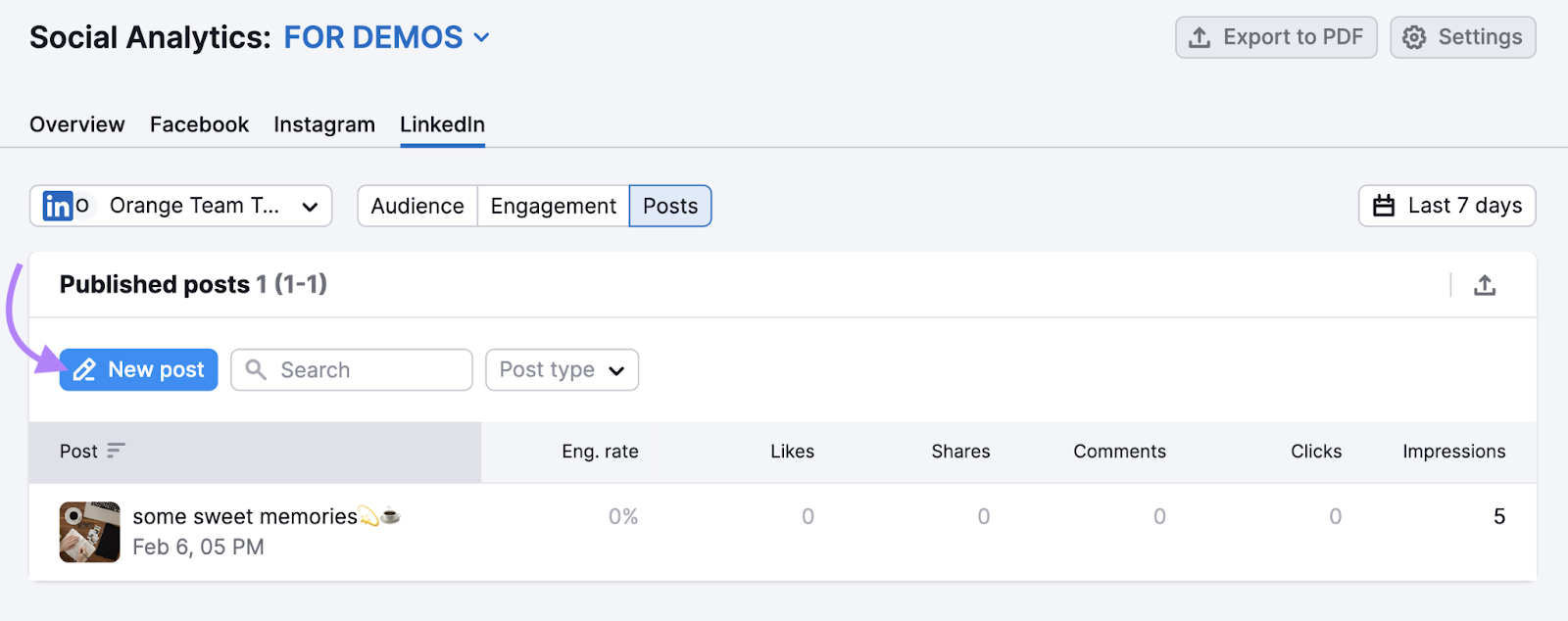
Tips for Personal LinkedIn Marketing
Setting up a personal LinkedIn profile is useful if you’re job searching, building a personal brand, or want to network and share thought-leadership content.
Let’s look at how to market on LinkedIn as an individual:
Create a Personal Profile
The first step to establishing your presence on LinkedIn is to create your personal profile.
This is your opportunity to highlight your skills, experience, and goals.
Start by creating your LinkedIn account.
Enter basic details like your full name, location, and email address.
Next, you’ll be prompted to enter your most recent job title, employment type, and company.
This information will be shown in the Experience section of your profile when it’s ready.
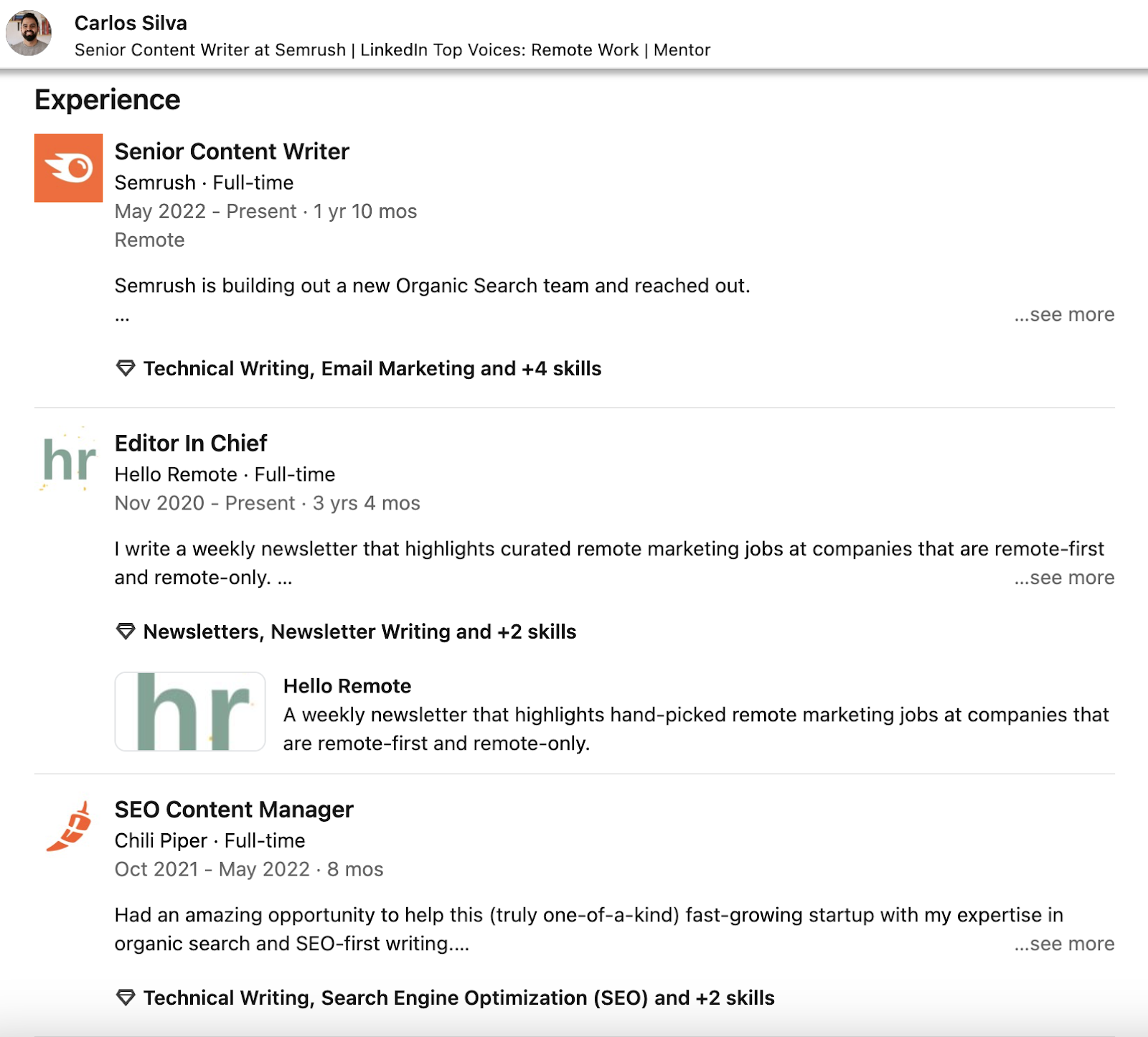
While creating your profile, LinkedIn will also ask you to add a profile photo.
Your photo is often one of the first things people notice about your profile.
To make a great first impression, choose a photo that’s:
- High-quality and not pixelated
- Well-lit, preferably with natural light, to avoid shadows and glare
- Reflective of how you look now
- Focused on your face as the central feature
- With a neutral background that doesn’t distract from your face
- Correctly framed, with your face ideally in the center and space around the top of your head and sides
Here’s an example of Semrush Senior Content Writer Carlos Silva’s profile picture. It’s high-quality, friendly, and professional:
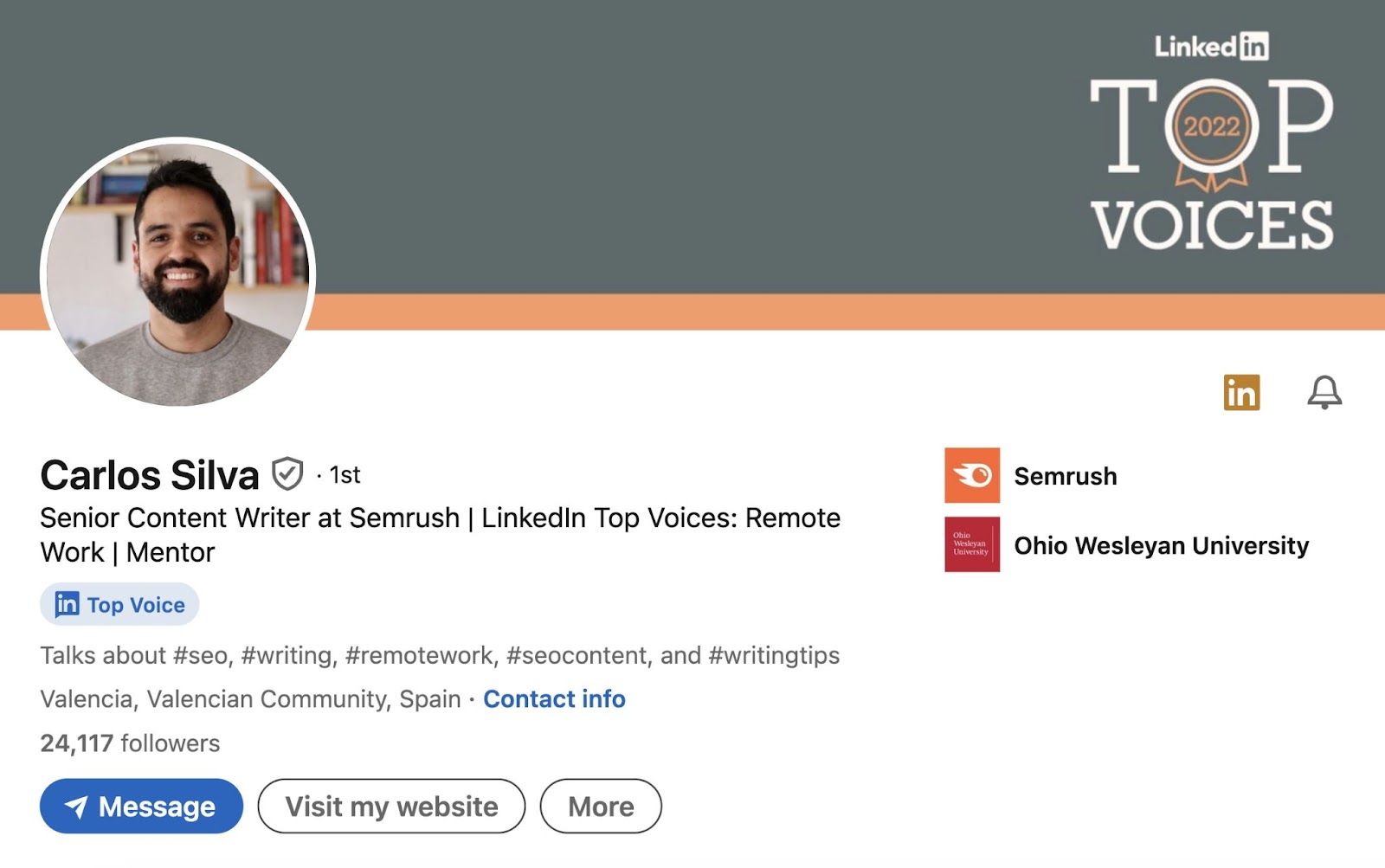
Once you’ve added your photo, adjust it by zooming, straightening, and repositioning until it fits perfectly on your profile.
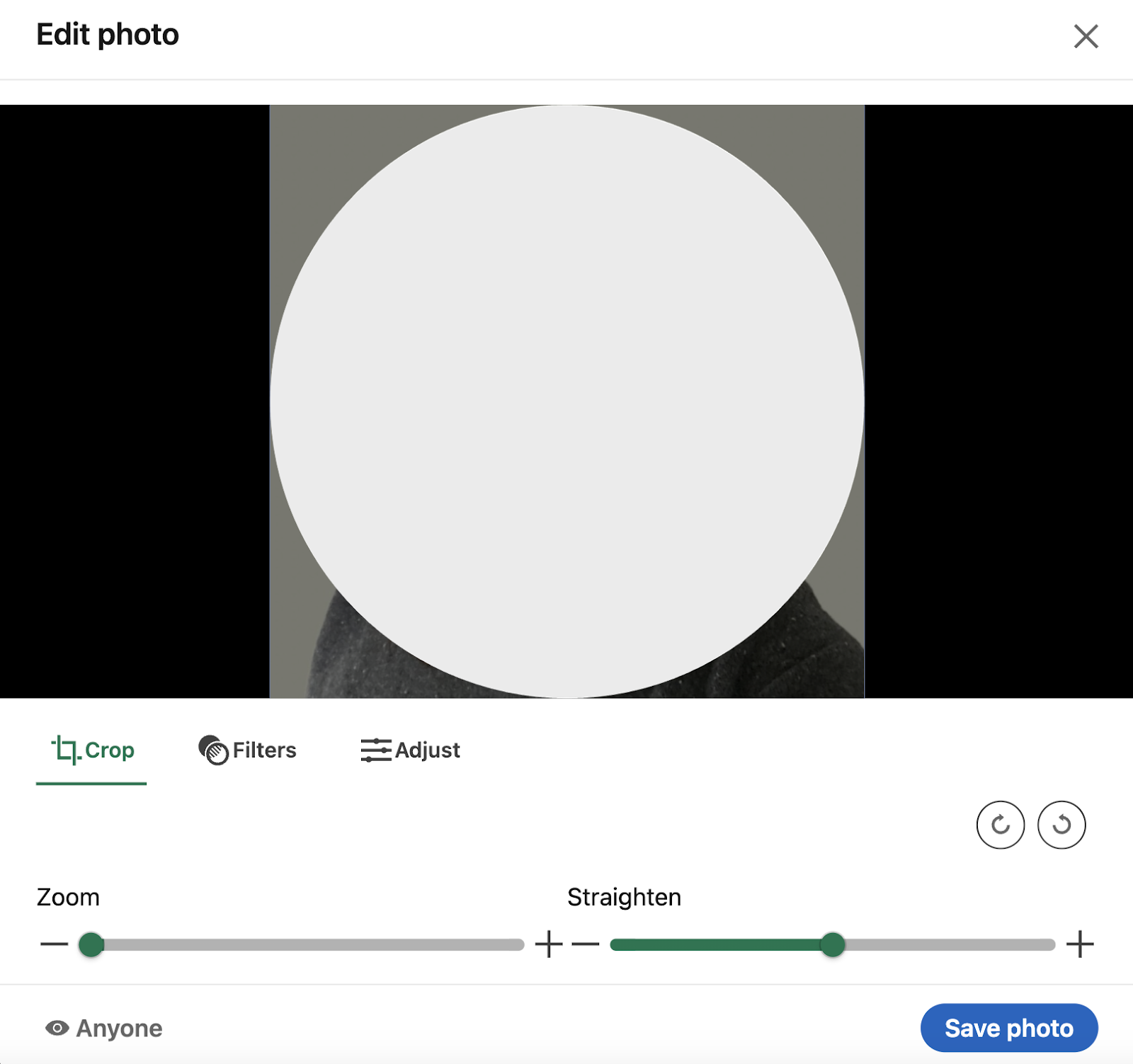
When you’re ready, click “Save photo” and “Continue.” And with that, your profile is up and running.
Craft a Compelling Headline
Your LinkedIn headline tells people who you are and what you do at a glance. It gives others a quick idea if you’re someone they’d like to connect with, follow, or maybe even hire.
Here’s an example from freelance B2C writer Emma Cownley’s profile:
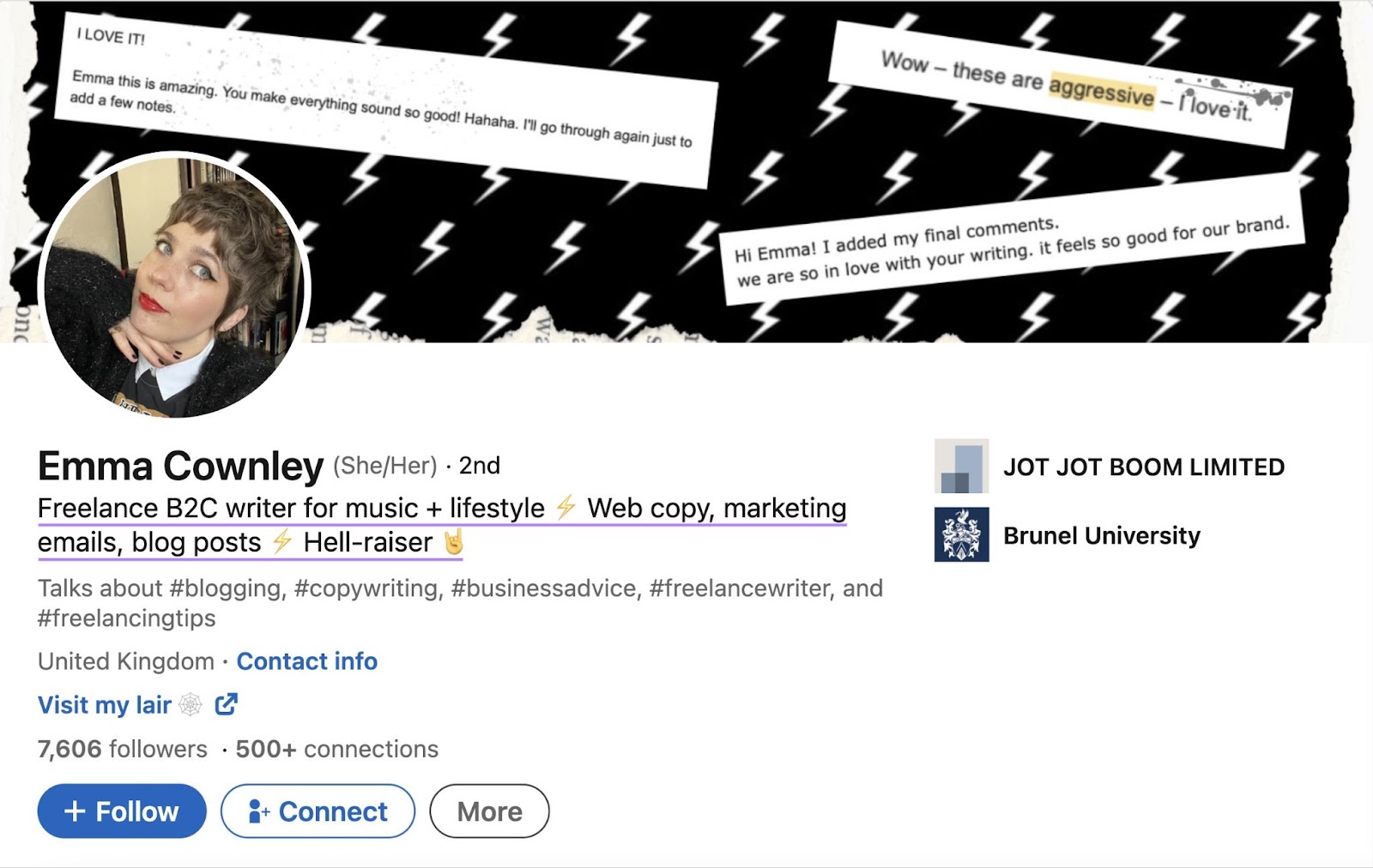
A first-time visitor will instantly know what this creator does (freelance writing,) what industry she’s active in (music and lifestyle), and what her specialties are (web copy, marketing emails, and blog posts).
One way to write a clear headline is to start with your role and current company or niche.
Here’s an example from Semrush Social Media Manager Julia Holmqvist’s profile:
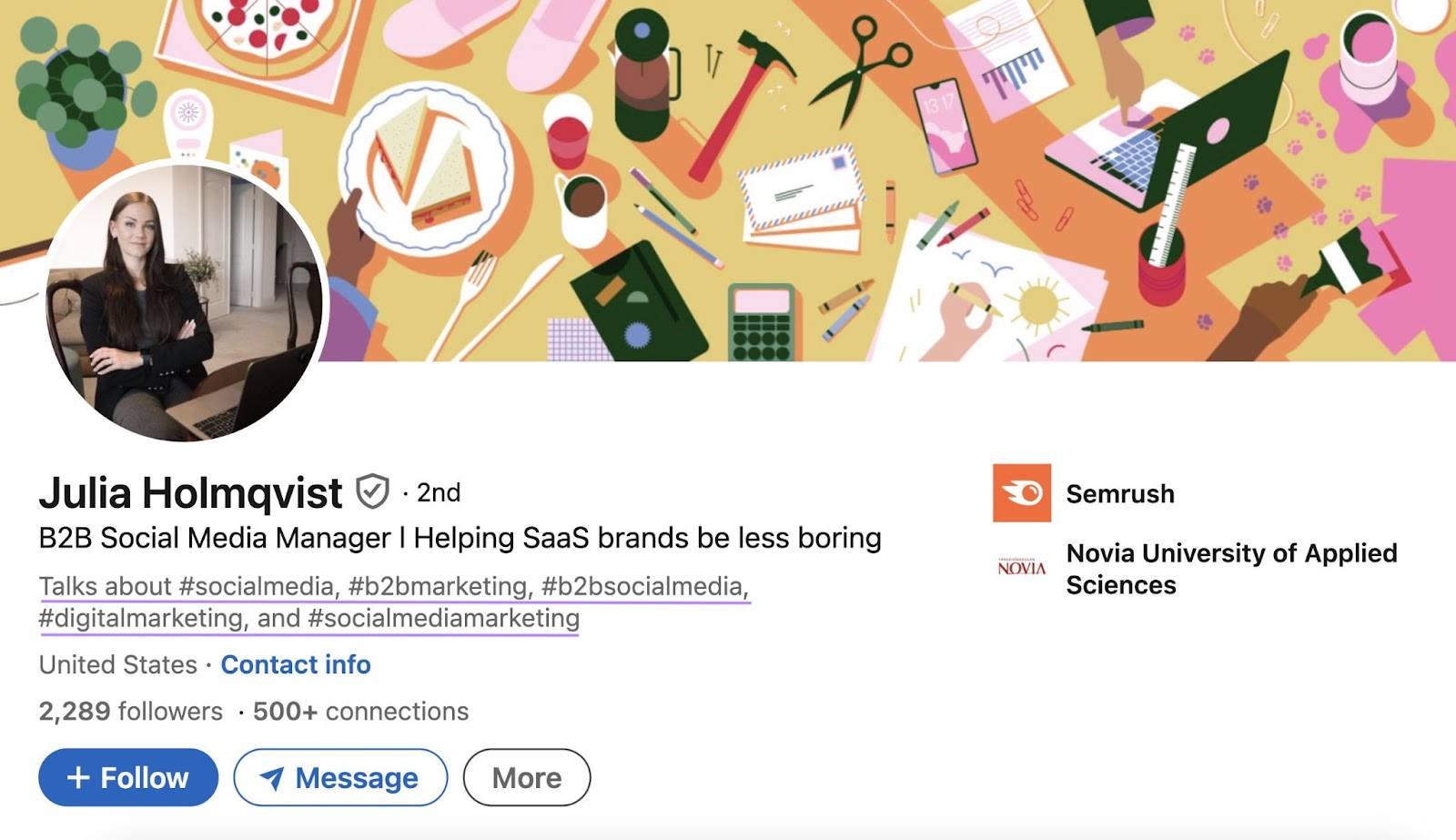
Add a brief description of your primary skills or achievements. Focus on what sets you apart.
Zaria Parvez, Duolingo’s senior global social media manager, does this by including tags like “Forbes #30Under30” and “Adweek Creative 100” in her headline:
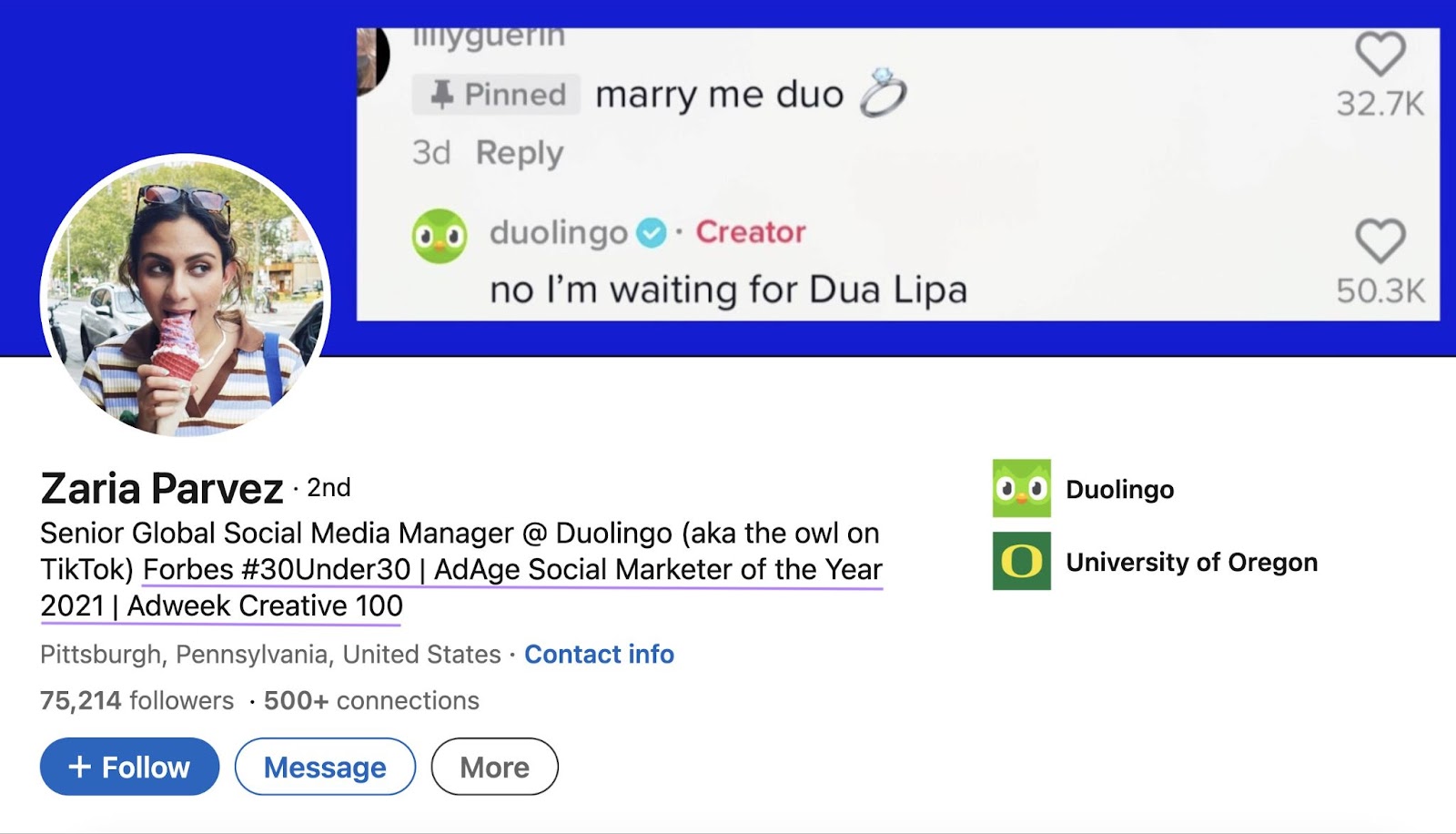
Finally, don’t be afraid to show a bit of personality. It can make your profile feel more relatable and human.
John Bonini, Founder of Some Good Content, does this by including some fun facts about himself:
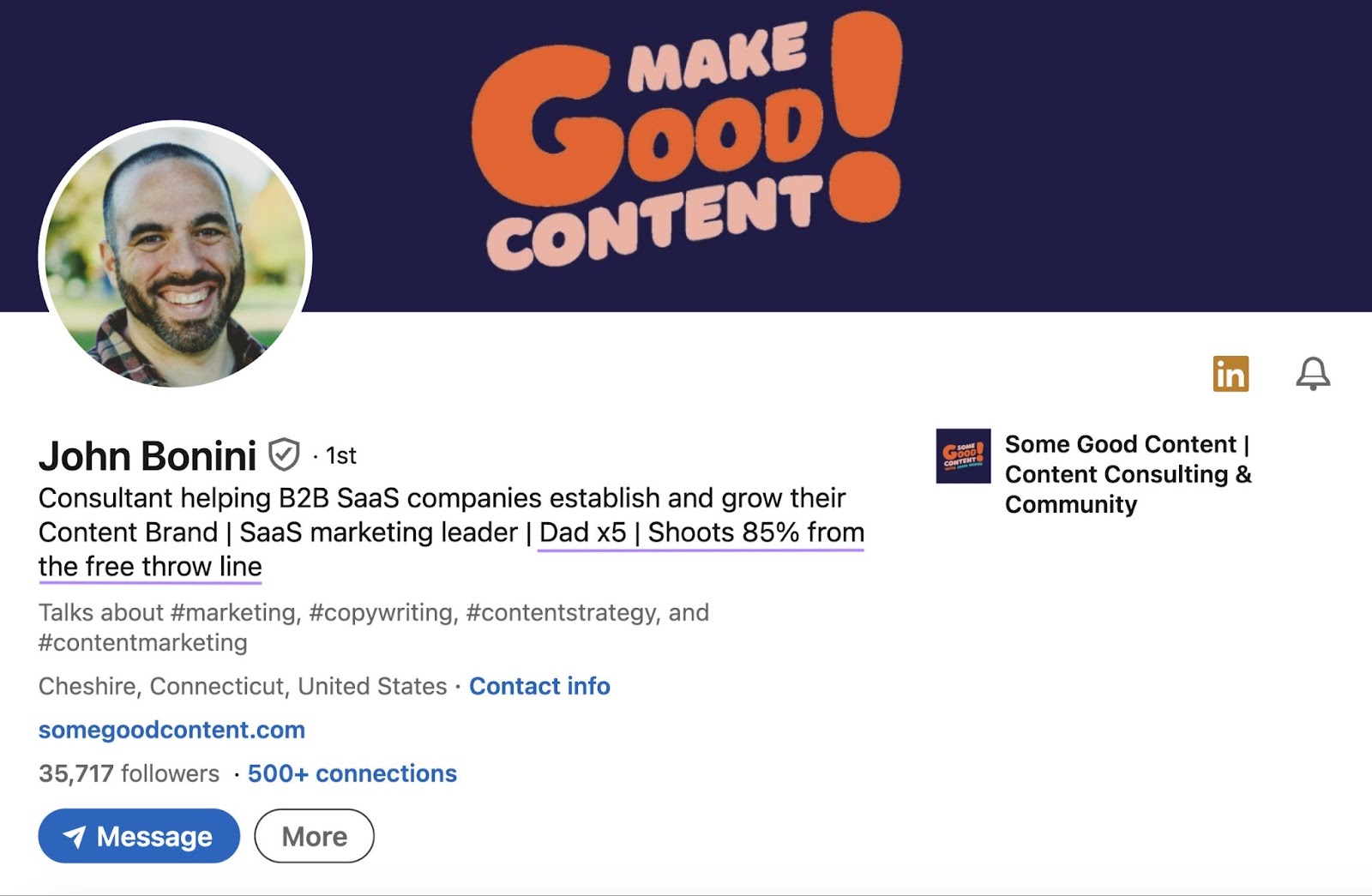
Personalize Your Profile
LinkedIn can sometimes feel impersonal or generic. This is because many profiles mirror each other in layout and adopt the same professional jargon and formal tone.
But people are naturally drawn to authenticity. If they see and feel the person behind the page, they’re more likely to trust and engage with the content.
Personalizing your profile helps your character shine through.
Here are four ways to customize your page:
Update Your Background Photo
Most profiles start out with a default, generic image like this:
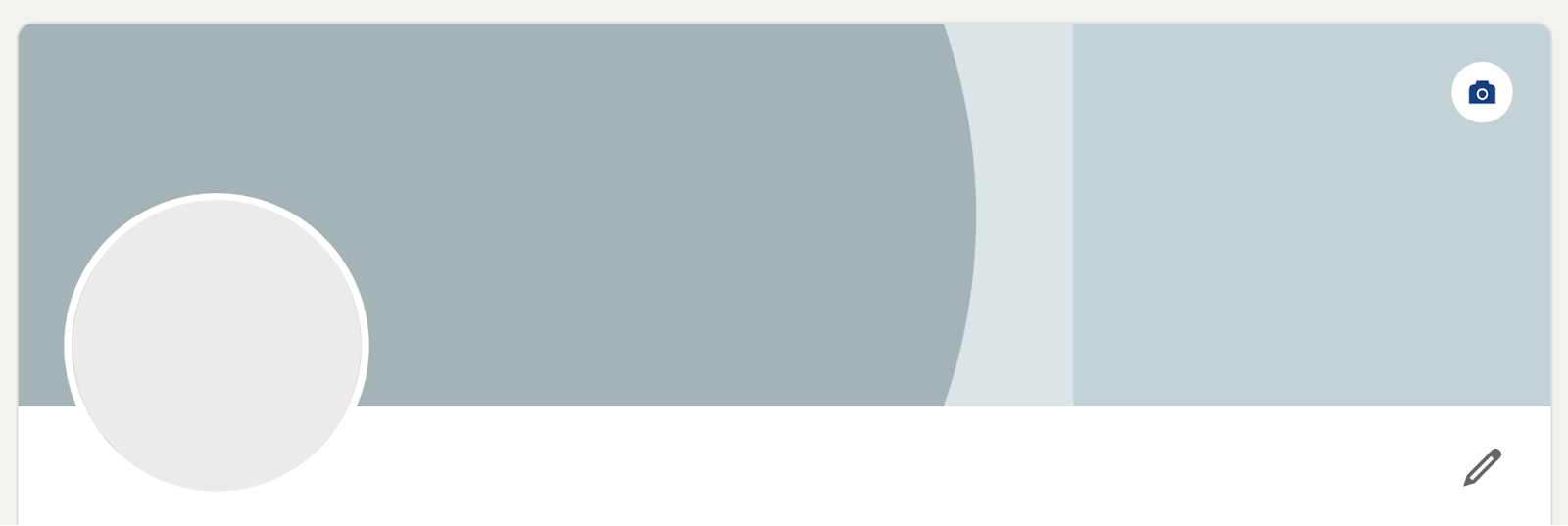
By changing this to something more personal and relevant to your career or interests, you can set your profile apart.
This could be any of the following:
- Snapshot of your city
- Photo of you at work
- Industry-specific visual
- Personal photo that speaks to your passions
- Simple visual summary of your offering
If you’re a business owner, here’s an example of how you can highlight your offering on your personal account from Databox CEO Peter Caputa:
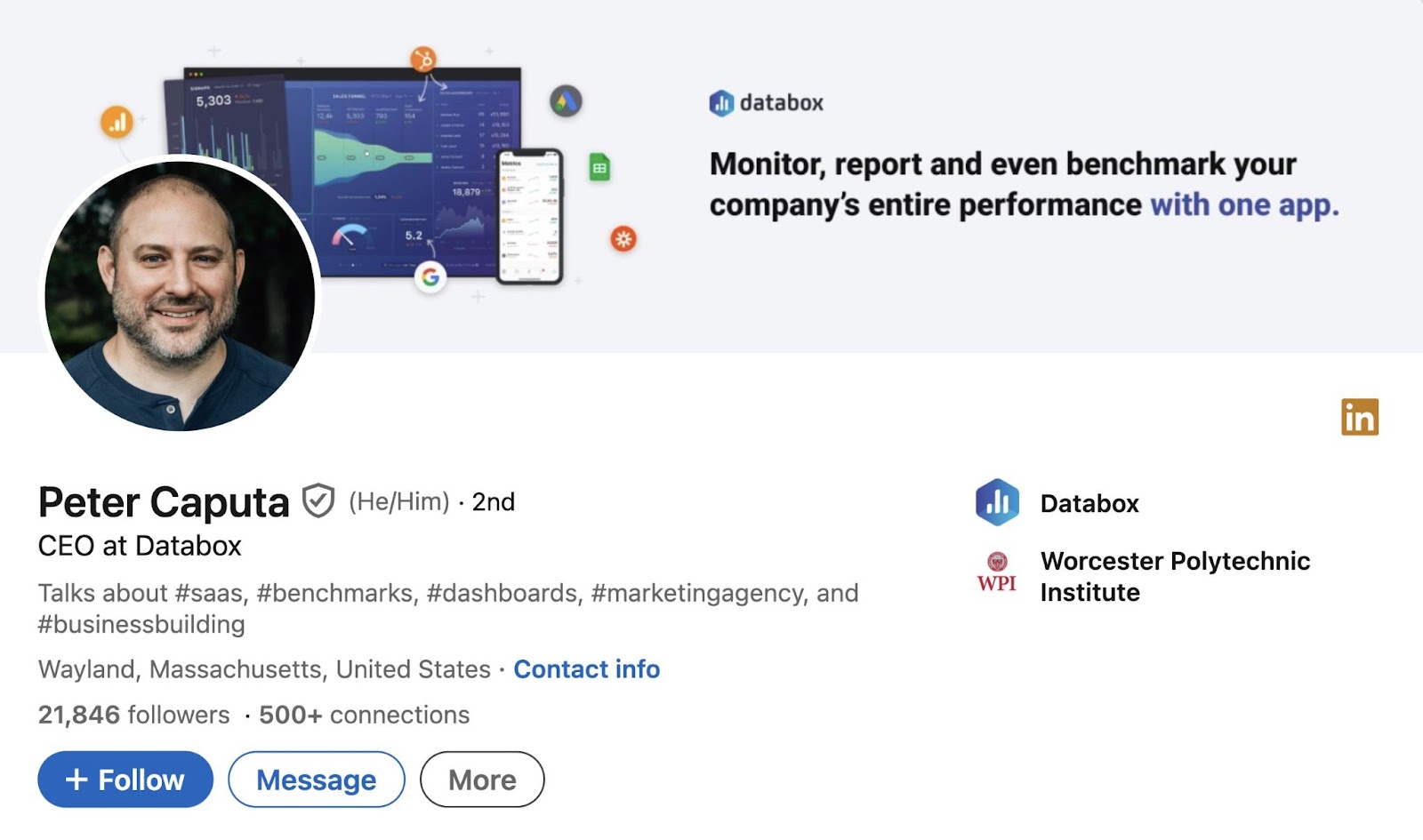
Jay Acunzo, co-founder of Creator Kitchen, has a background photo that captures him in his element, delivering a talk:
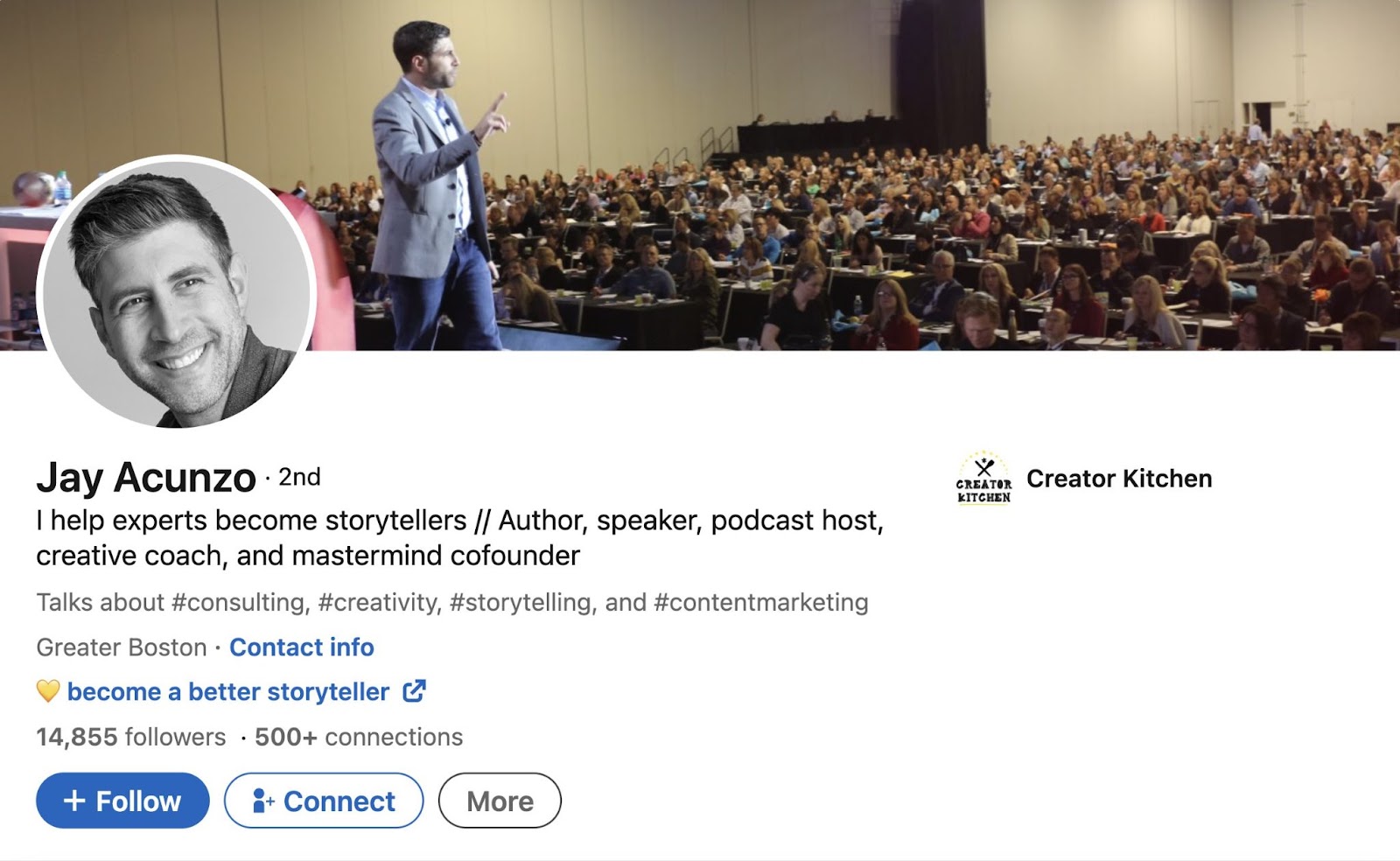
For the best results, make sure your background photo is:
- In JPG or PNG format
- Less than 8 MB in size
- 1584 (w) x 396 (h)
Add a Bio to Your ‘About’ Section
This space is your opportunity to tell your professional story in your own words, using a maximum of 2,600 characters.
Share what makes you unique in your field, explain what you’re looking for in your next role, or use the space to get leads for your freelance business.
Here’s a great example of how Kate Erwin, social media lead at Beam Content, does this:
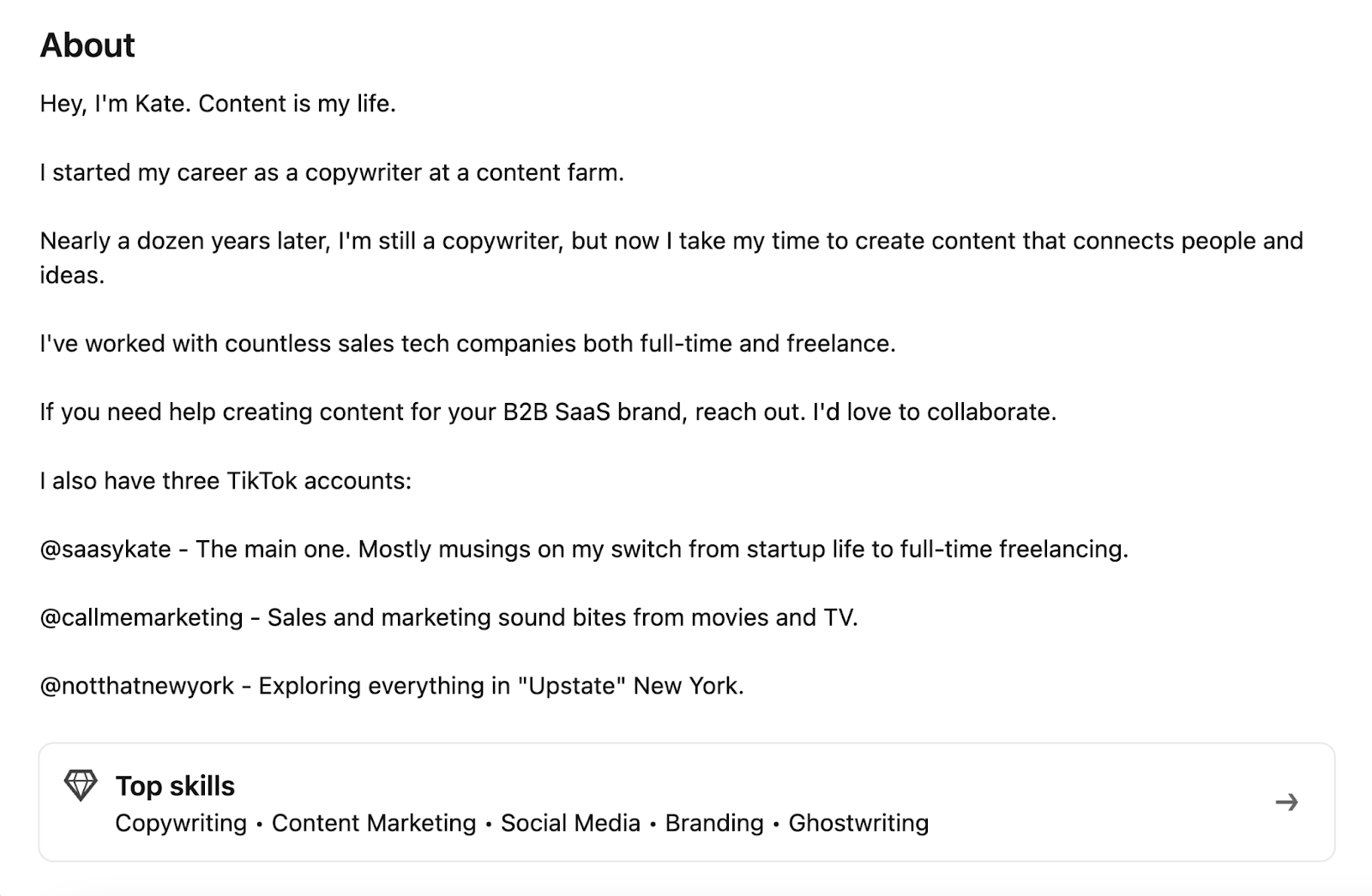
She establishes her passion and area of expertise right away, speaks directly to potential clients, and acknowledges their primary pain point.
Here’s another example from Lee Densmer, owner and content marketing strategist at Globia Content Marketing:
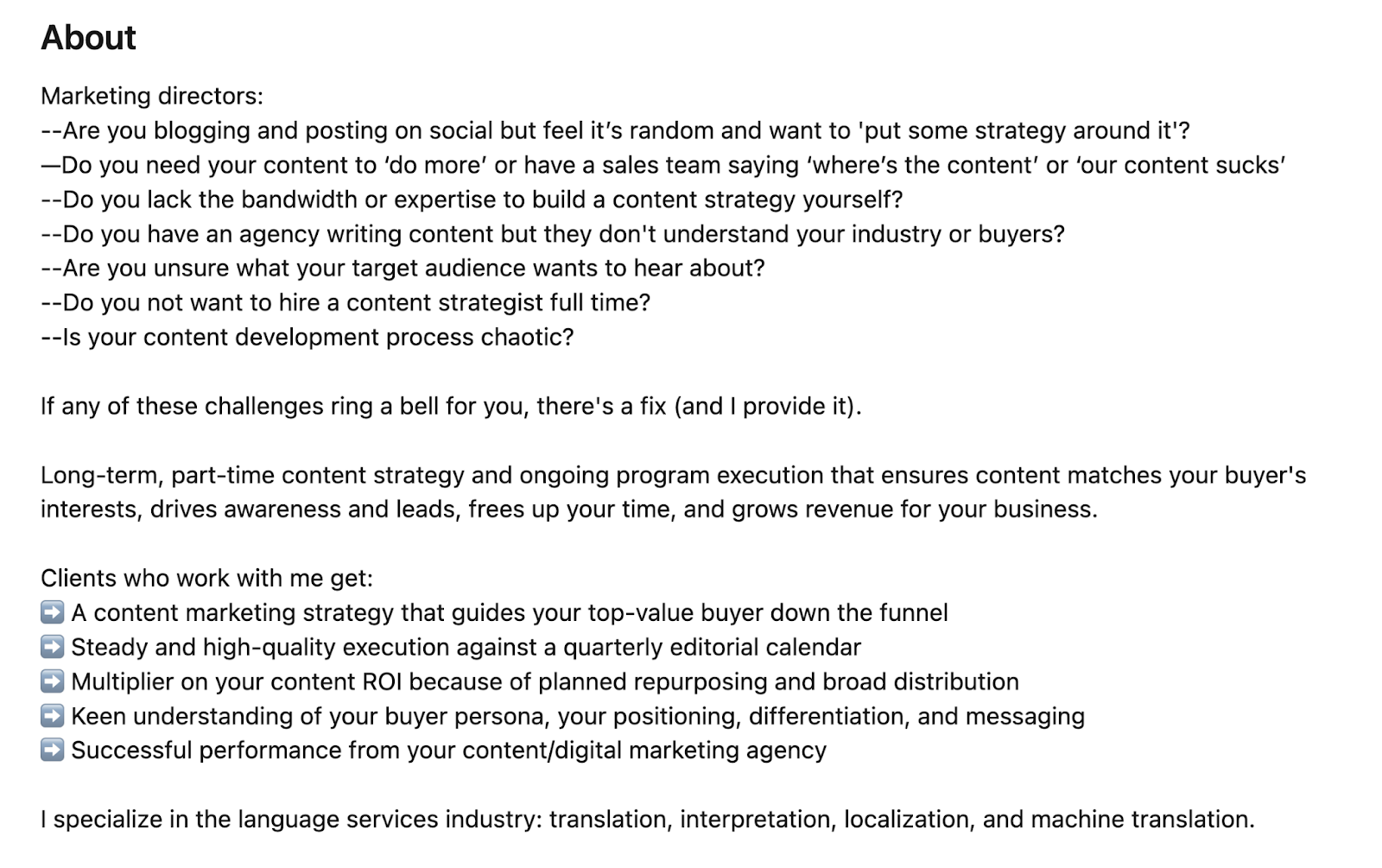
Lee starts the bio by directly addressing common challenges faced by marketing leaders. This immediately shows Lee’s deep understanding of the audience’s pain points and establishes expertise.
Lee then outlines her comprehensive solutions, highlighting the value she brings.
After some glowing testimonials and facts about herself, she wraps things up with a clear call to action (CTA) for her freelance services.
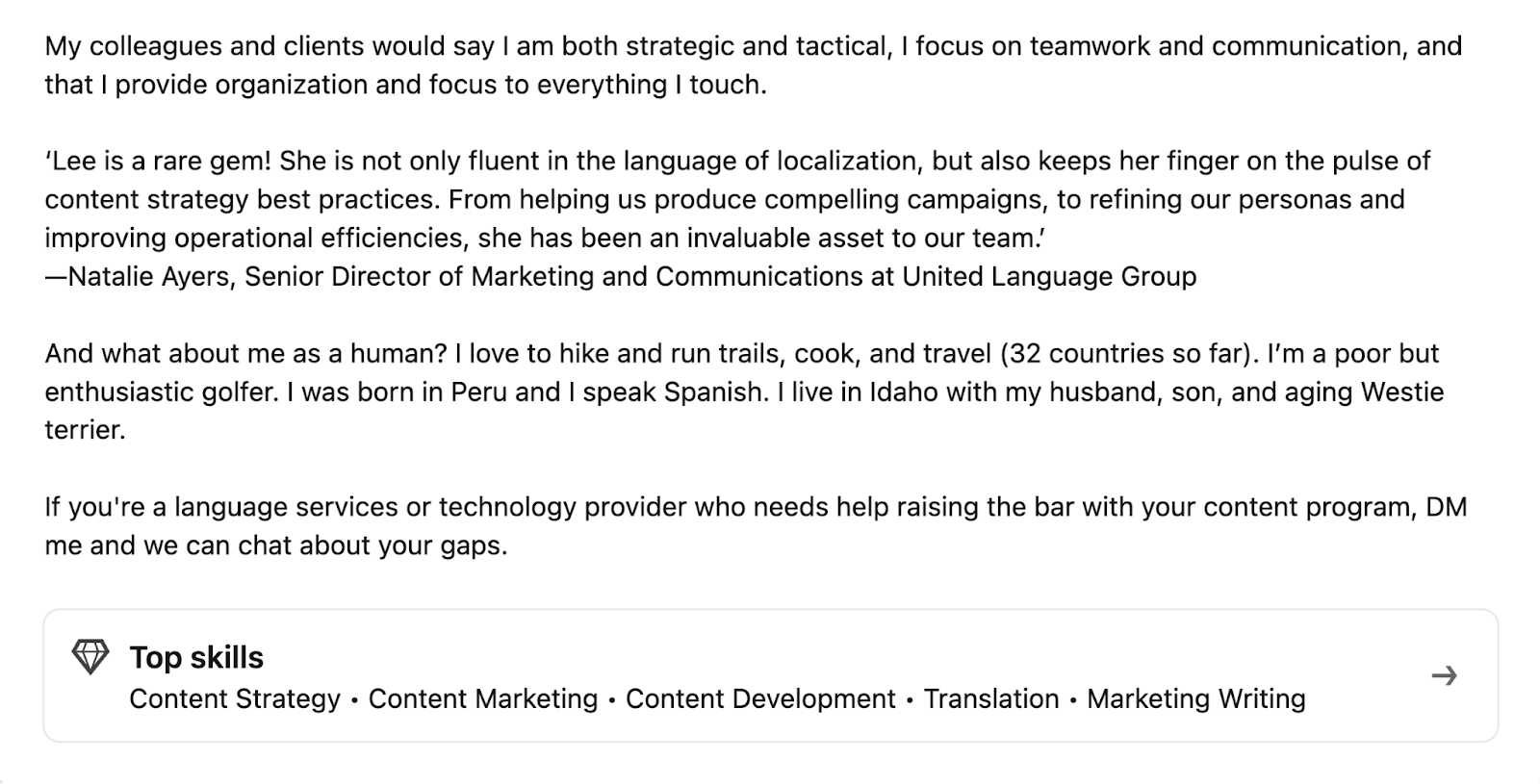
Record and Display Your Name Pronunciation
This feature is especially helpful if you have a name that’s often mispronounced.
But it also adds a personal touch and makes your profile more approachable. With this feature, you have 10 seconds to introduce yourself and give a quick pitch about what you do.
Plus, hearing your voice can give people a better sense of who you are. It’s like a mini introduction before they even dive into your profile.

Curate Your Featured Posts
This section of your profile is like your personal highlight reel. It lets you put your best work front and center.
Whether it’s posts you’re particularly proud of, key accomplishments, or a link to your portfolio, pinning them to your “Featured” section ensures they don’t get lost on your timeline.
Here’s how Eve Davitt, personal branding and LinkedIn coach, uses this space to highlight her services:
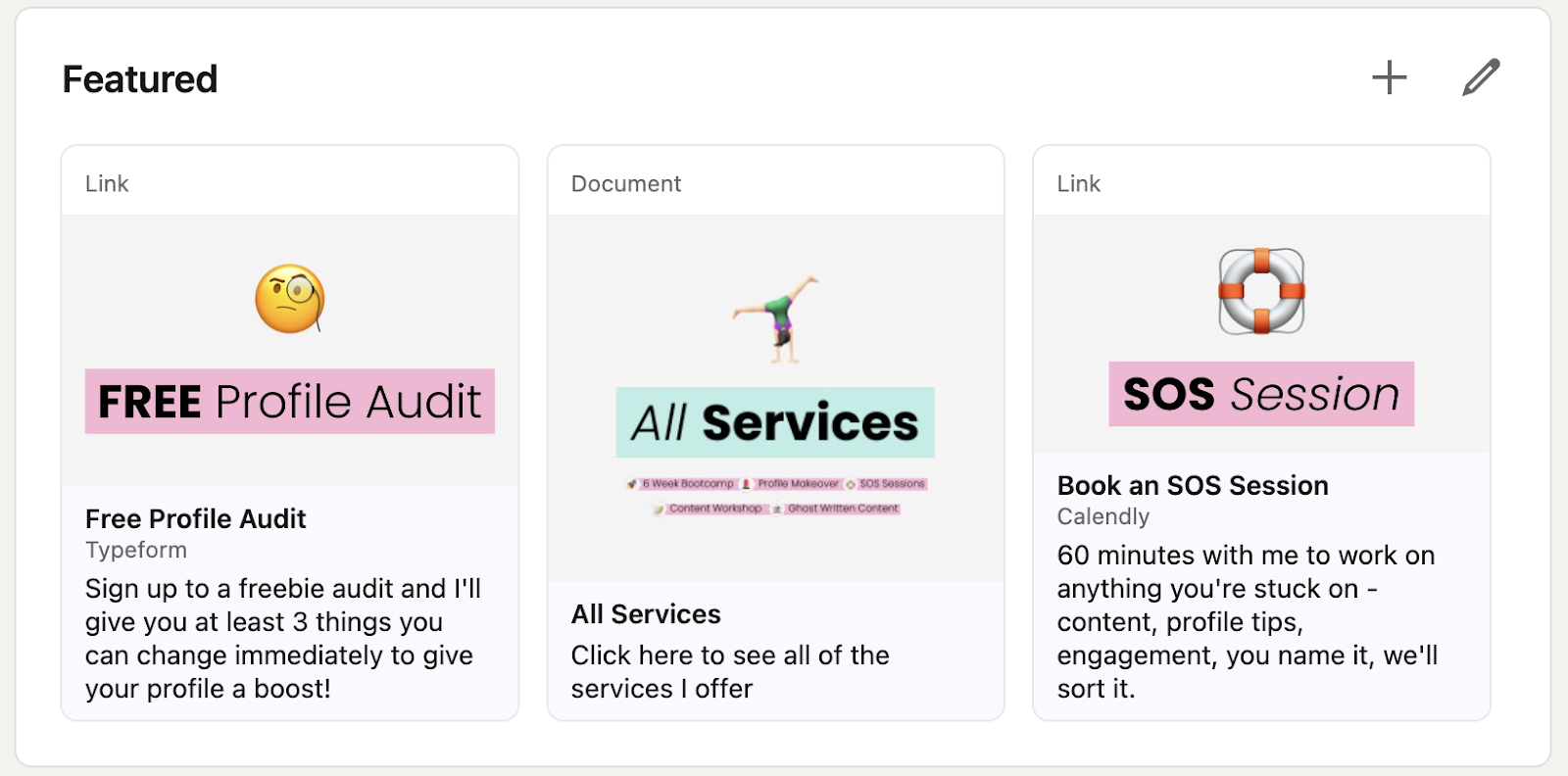
Create Original Content That Shows Expertise and Personality
There’s a lot that goes into growing your audience on LinkedIn. However, sharing original content is one of the most effective ways to market yourself.
Every piece of content you share on LinkedIn makes you more visible to your immediate connections and their networks.
Let’s say you’ve written a post about the best LinkedIn marketing tools.
When someone in your network interacts with this content—be it by liking, commenting, or sharing—LinkedIn pushes it out to that person’s connections or followers as well.
One of the easiest ways to get started with posting content is by choosing your content pillars.
Content pillars are the main themes or topics you consistently talk about and want to be known for. They give your LinkedIn marketing strategy a clear focus and direction.
Your particular content pillars depend on your expertise, industry, and goals. But they should reflect what you know best and what you’re passionate about.
Some examples include:
- Growth-centric: Posts designed to engage your audience and showcase your personality. These could include personal stories, professional updates, or even selfies.
- Authority-building: Educational insights that position you as an expert in your field. For example, how you accomplished a certain task, thought leadership pieces, or your take on trending topics.
- Promotional: Content focused on marketing your products or services, highlighting past results and case studies, or sharing testimonials.
- Entertaining: Light-hearted or engaging content that adds a human touch—like relatable stories or even memes.
Beam Content Co-Founder Brooklin Nash uses humor to connect with his audience in this entertaining example:
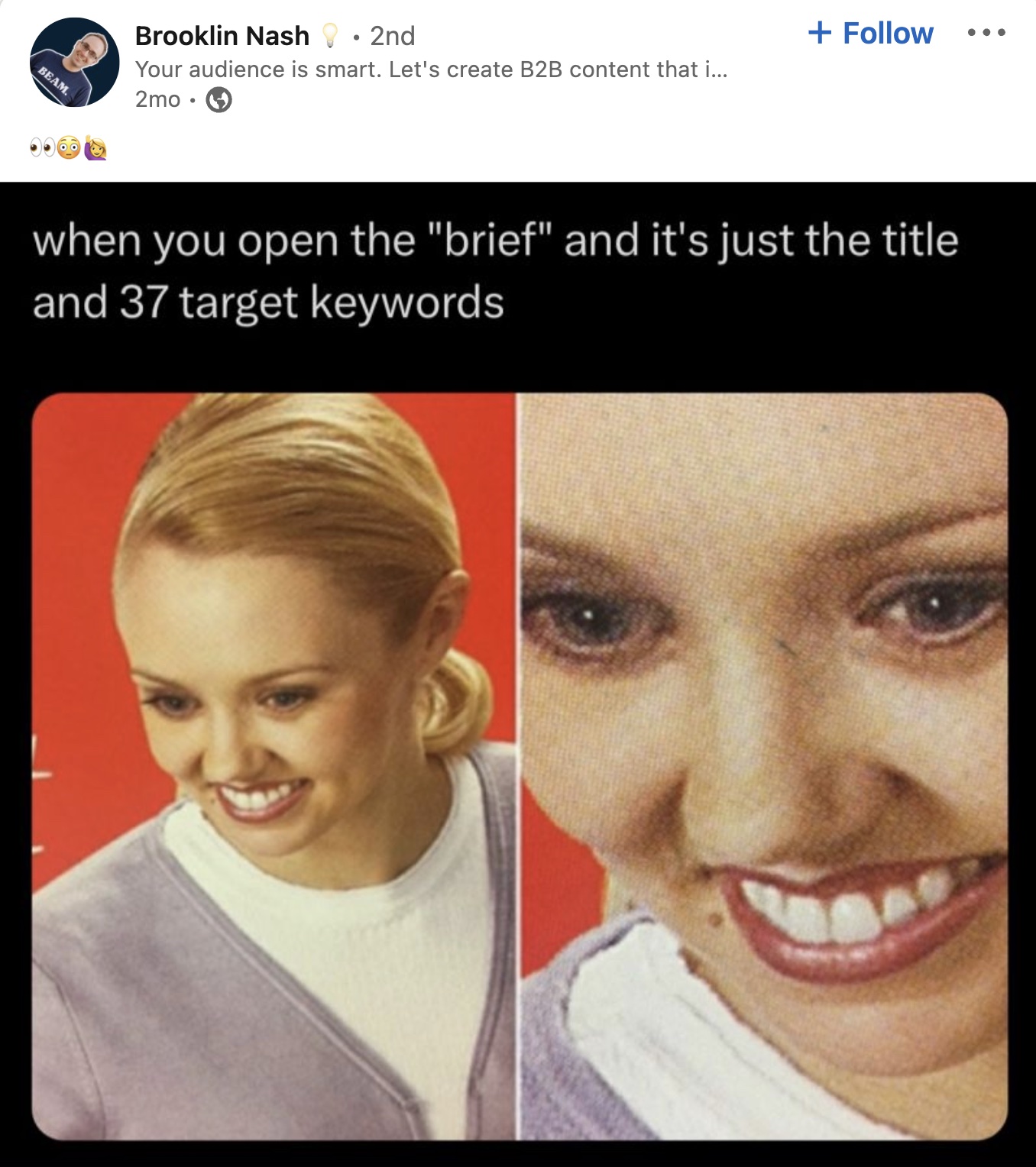
Choose three to five pillars that resonate most with your strengths and goals and rotate between them. The idea is to choose areas where you can provide valuable insights and engage meaningfully with your audience.
Vary Post Length
Mixing up post length keeps your content engaging and appealing to different audiences.
Short posts are great for quick updates, sharing a thought, or entertainment. They’re also easy to read, which is perfect for users scrolling through LinkedIn on a busy day.
For example, this short post takes advantage of the Halloween spirit to humorously address a common freelancer pain point:

Longer posts let you go into more detail. They’re ideal for sharing educational content, comprehensive insights, or storytelling. It gives you the space to provide value and demonstrate your knowledge.
The post below educates readers, primarily freelancers, on how to pitch their services to their target audience and send effective cold DMs:
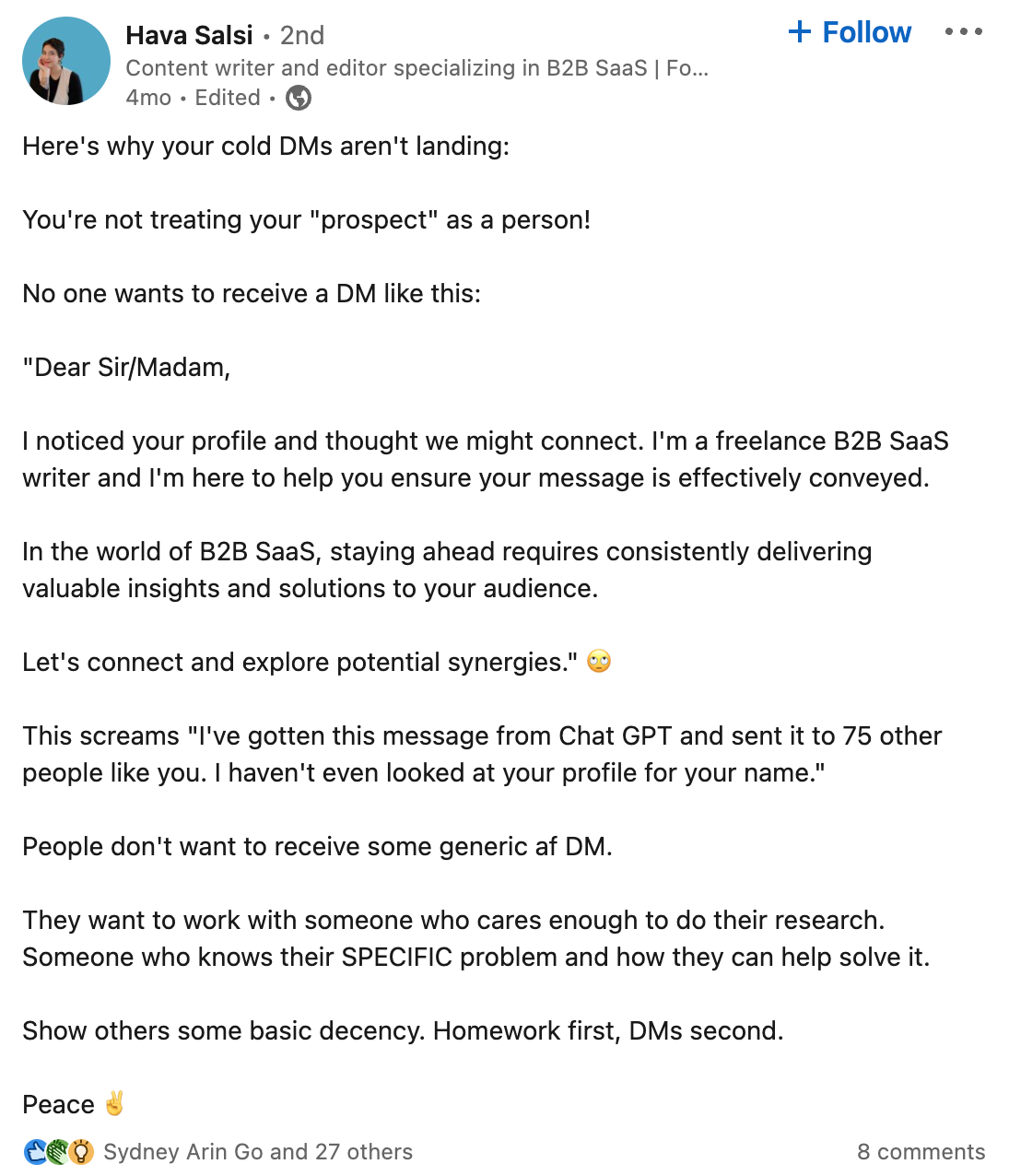
The trick is to balance the two. A mix of short and long posts keeps your content fresh and interesting.
Use a Mix of Content Formats
Using a variety of formats—like videos, audio, images, and written posts—gives your audience a choice in the type of content they consume and engage with.
It also means there’s always something for every type of follower.
For example, some people might skim a long article, but they’ll stop scrolling for a short video. Others might skip a podcast clip but get hooked on a short, written post.
Some users might not have time to read a detailed guide. But they’ll look through your carousel of images.
The easiest way to find out what resonates with your followers is to ask them what type of content they prefer. And what topics they’re interested in.
Do this either through a simple post, asking for their input in the comments, or by creating a poll.
For example:
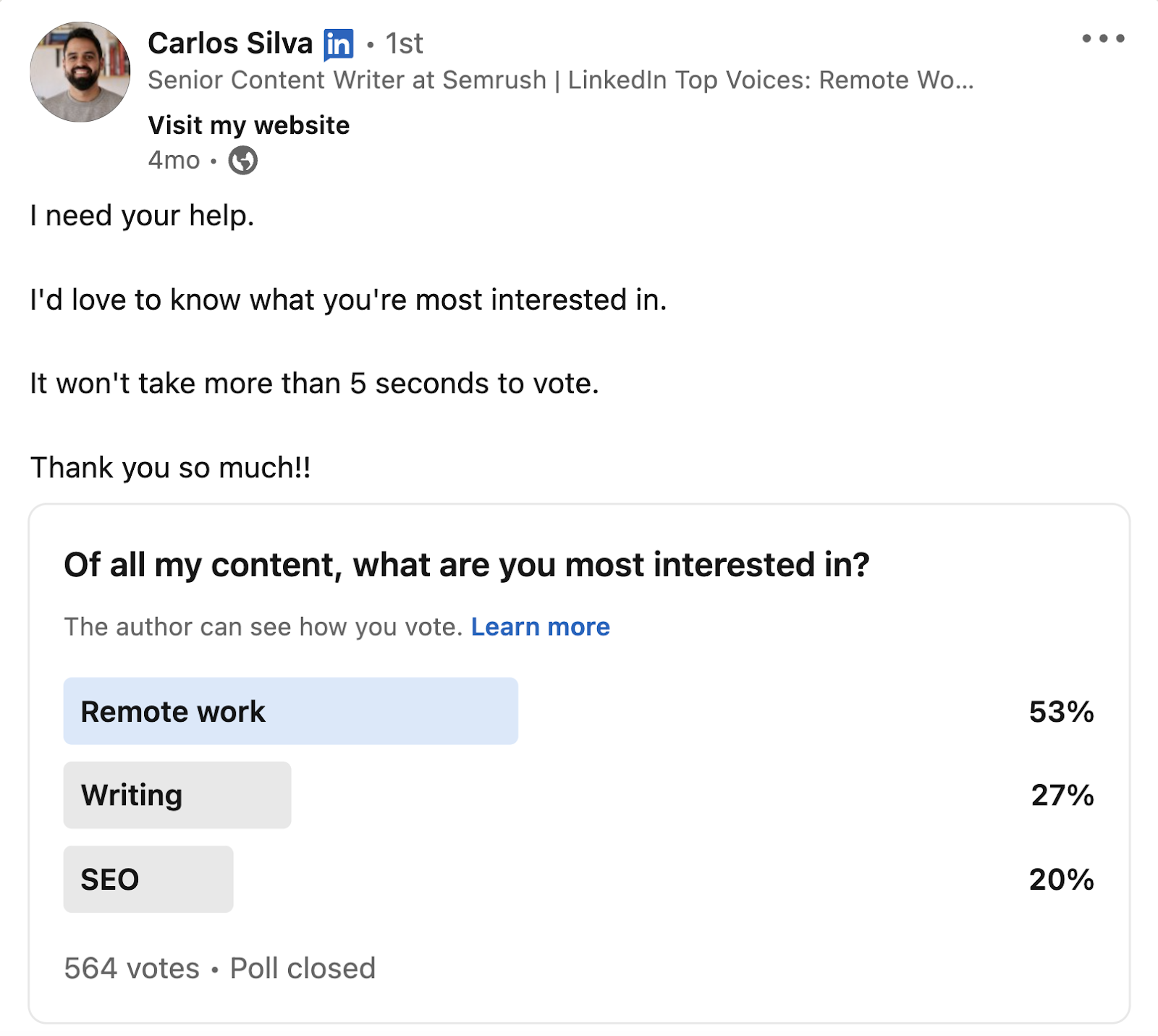
To view post-performance analytics, click the “Me” icon in the top-right corner of your personal LinkedIn account.
Next, scroll down to the “Analytics” section, and click “Show all analytics.”

Here, you’ll find four key metrics. The most relevant one for this purpose is “Post impressions.”
Click “Post impressions” to see an overview of your content’s performance in the last seven days. Impressions refer to the number of times your content shows up on someone’s screen.
If you want to analyze your content over a different time frame, click the “Past 7 days” button. This lets you filter the data by various periods, like 14 or 28 days.
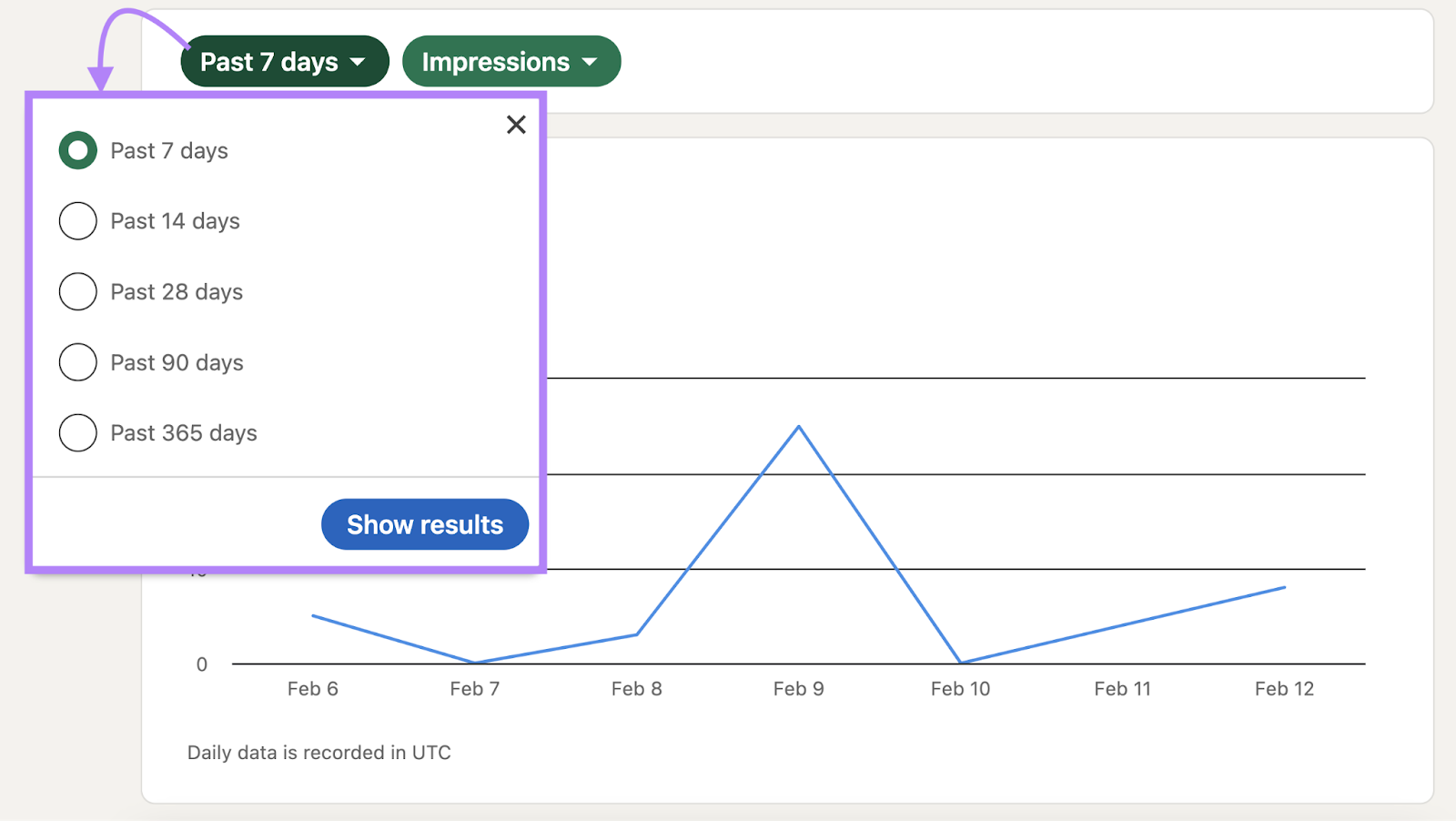
Scroll down to the “Top performing posts” section for a more detailed breakdown of the content your audience prefers.
If your top-performing posts are videos and short posts, for example, it’s clear your audience prefers those formats.
Use this insight to tailor your future content strategy, focusing more on these types of content to maximize engagement and reach on your LinkedIn profile.
Use Hashtags
When you use hashtags, your posts can pop up in the feeds of those who search for those tags, even if they aren’t connected to you.
This broadens your reach beyond your immediate network, getting your content in front of eyes that might otherwise never see it.
However, overusing hashtags or using ones that aren’t relevant can have the opposite effect.
To avoid this, stick to three to five hashtags that are most aligned with your post’s content or industry.
Let’s say you’re writing a post on LinkedIn marketing courses. You could start with #Linkedinmarketing as a broad hashtag.
Then, to narrow it down and target more specific audiences, add hashtags like #DigitalMarketingCourses or #SocialMediaTraining.
If you’re out of ideas, start typing the hashtag, and LinkedIn will give you suggestions on how to finish it.
For example, if you type #content, LinkedIn might suggest related tags like #contentwriting, #contentoptimization, or #contentmarketing tips.
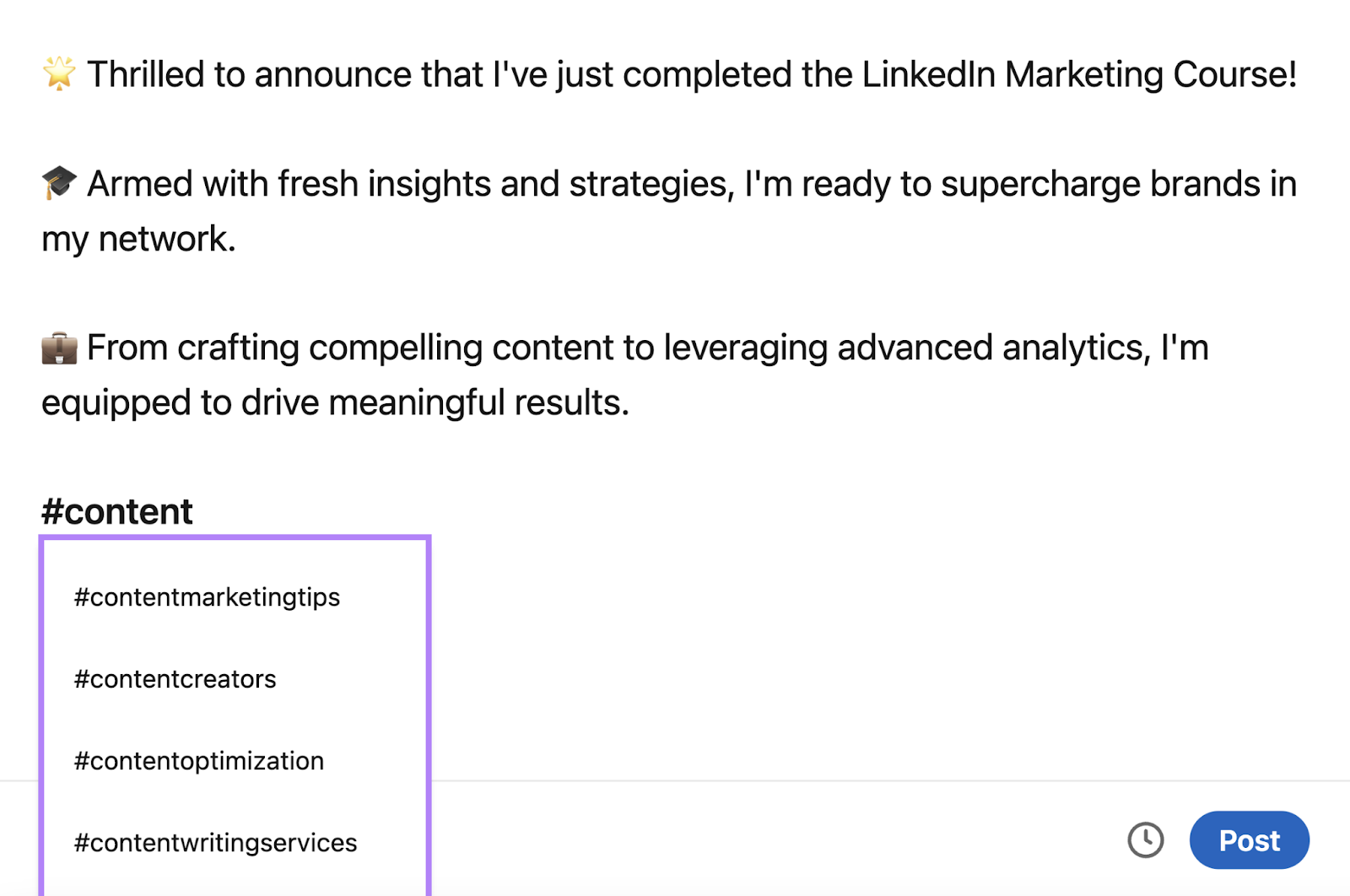
Go through the list and pick the ones that make the most sense for your post.
Post Consistently
If you want to stand out on LinkedIn, stick to a regular posting schedule.
Consistency builds trust and gets you noticed by your target audience.
For instance, regularly sharing industry insights and contributing to discussions can showcase expertise, potentially leading to job opportunities from companies on LinkedIn and recruiters.
Additionally, frequent updates on project accomplishments can attract attention from those looking for specialized skills, opening doors to freelance opportunities.
Remember, consistency on LinkedIn doesn’t mean you need to post every day. What matters most is finding a cadence you can keep up with long-term.
The Social Poster tool can help you quickly draft and schedule content for your personal (and business) LinkedIn account, as well as Facebook, Instagram, Pinterest, and X.
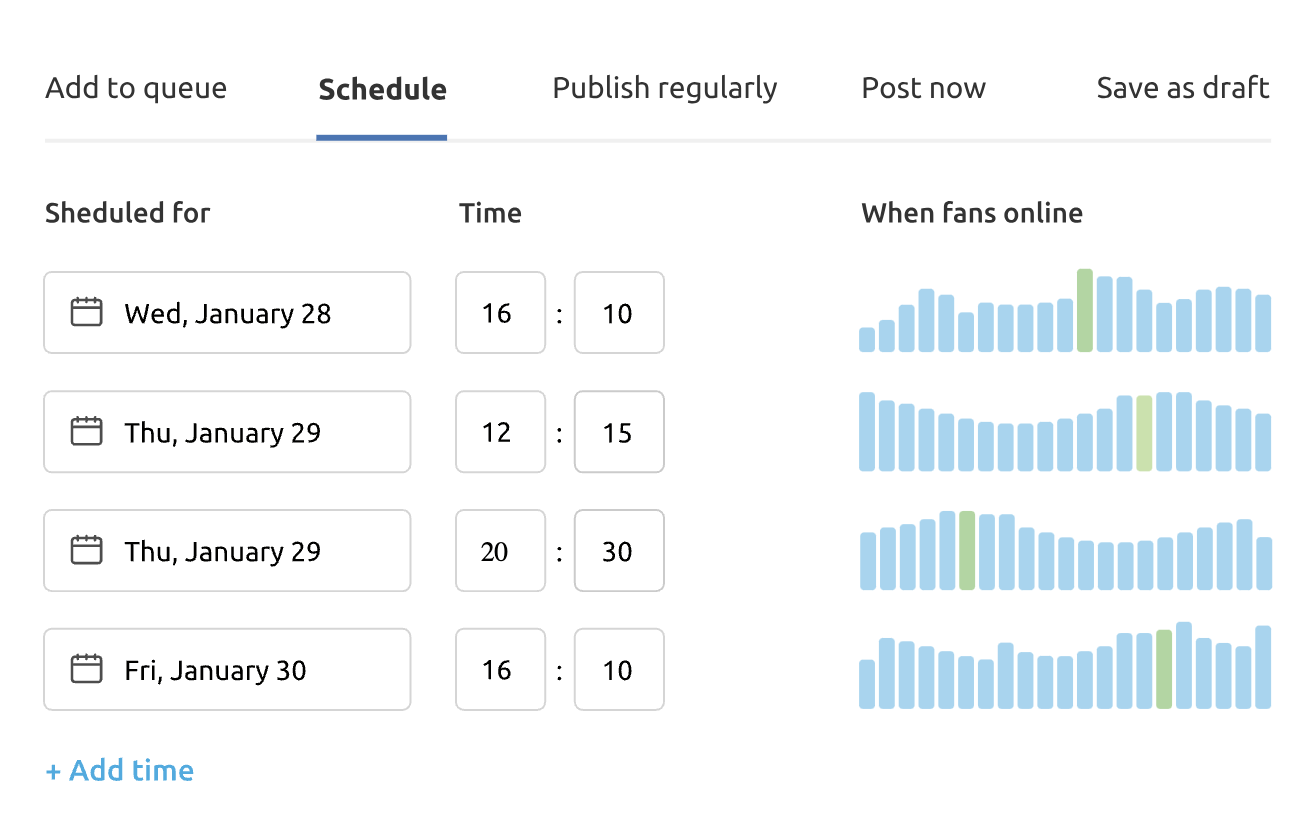
Make Your LinkedIn Profile Search Engine-Friendly
LinkedIn search engine optimization (SEO) helps your profile show up in search results—both on LinkedIn and search engines like Google.
This means more people can find you. Especially those looking for the skills or services you offer.
A big part of making your LinkedIn profile search-friendly is using the right keywords.
Think about the words that describe what you do best—your skills, job title, and areas of expertise. Then, include them in your headline, “About” section, and “Experience” descriptions.
But don’t go overboard. Stuffing your profile with too many keywords can make it look unnatural and turn people off.
For your headline, pick keywords that clearly state what you do and what you specialize in.
For example, if you’re a designer like Kortney Melchiorre, your keywords might include “graphic design,” “UX/UI,” “brand development,” or “visual storytelling.”
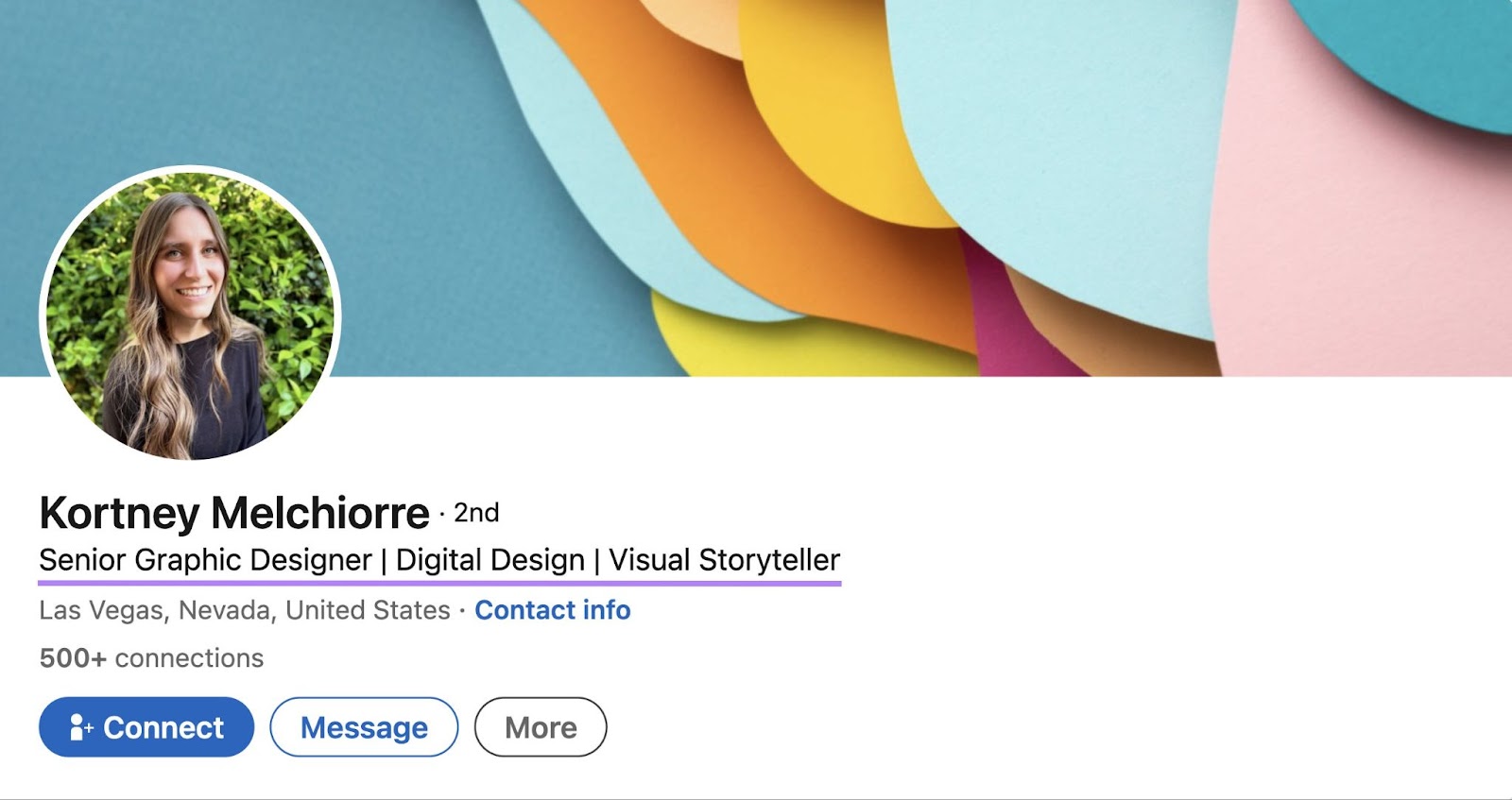
In your “About” section, use keywords to guide the narrative. Talk about how you’ve grown in your field, the kind of projects you’ve loved working on, and what you bring to the table.
The “Experience” section is all about specifics. Use keywords to underline what you did in each job and how you applied your expertise in real-world situations.
Here’s an example from Olga Andrienko, Semrush’s VP of brand marketing:
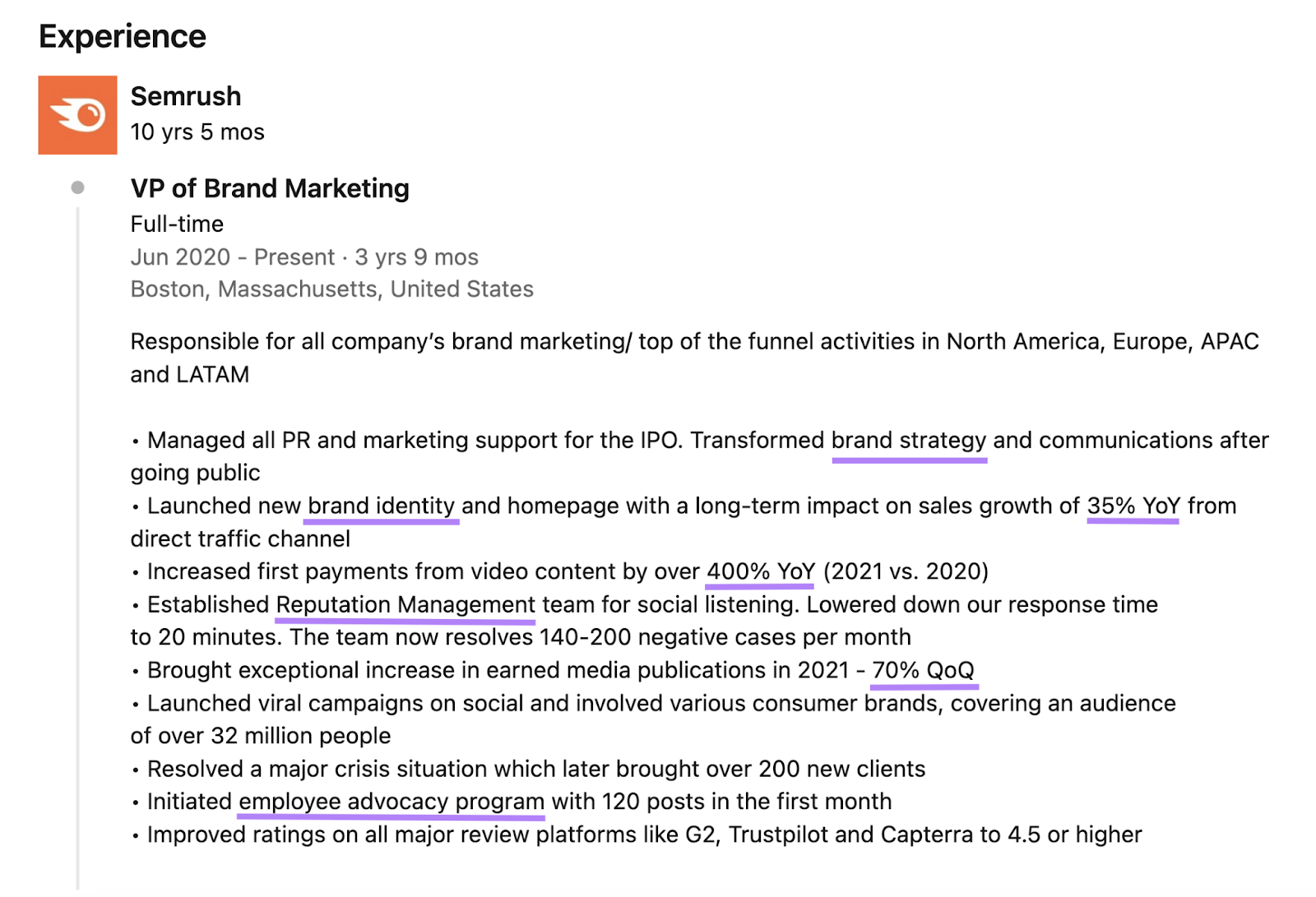
Further reading: LinkedIn SEO: Optimize Your Profile for Improved Visibility
Add a Custom Button to Your Profile
Adding a custom button to your profile lets you direct visitors to your main value proposition. It summarizes your offering and helps generate leads or drive traffic to your latest projects.
Use the custom button feature to link to your website, portfolio, podcast, newsletter signup page, and more.
Jessica Walrack uses the custom button feature to display their writing services:
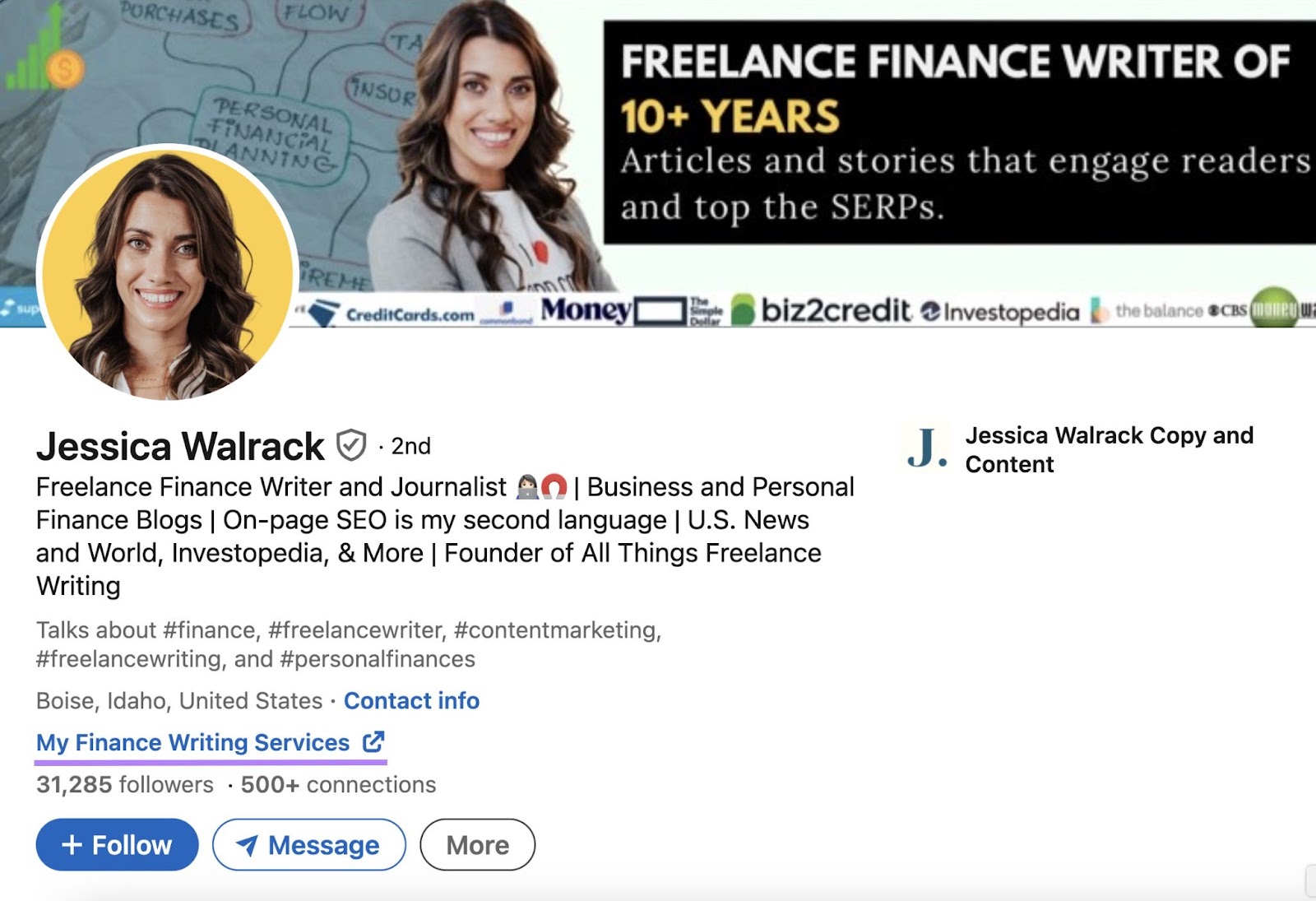
To add a custom button, head over to your profile and click the edit button.
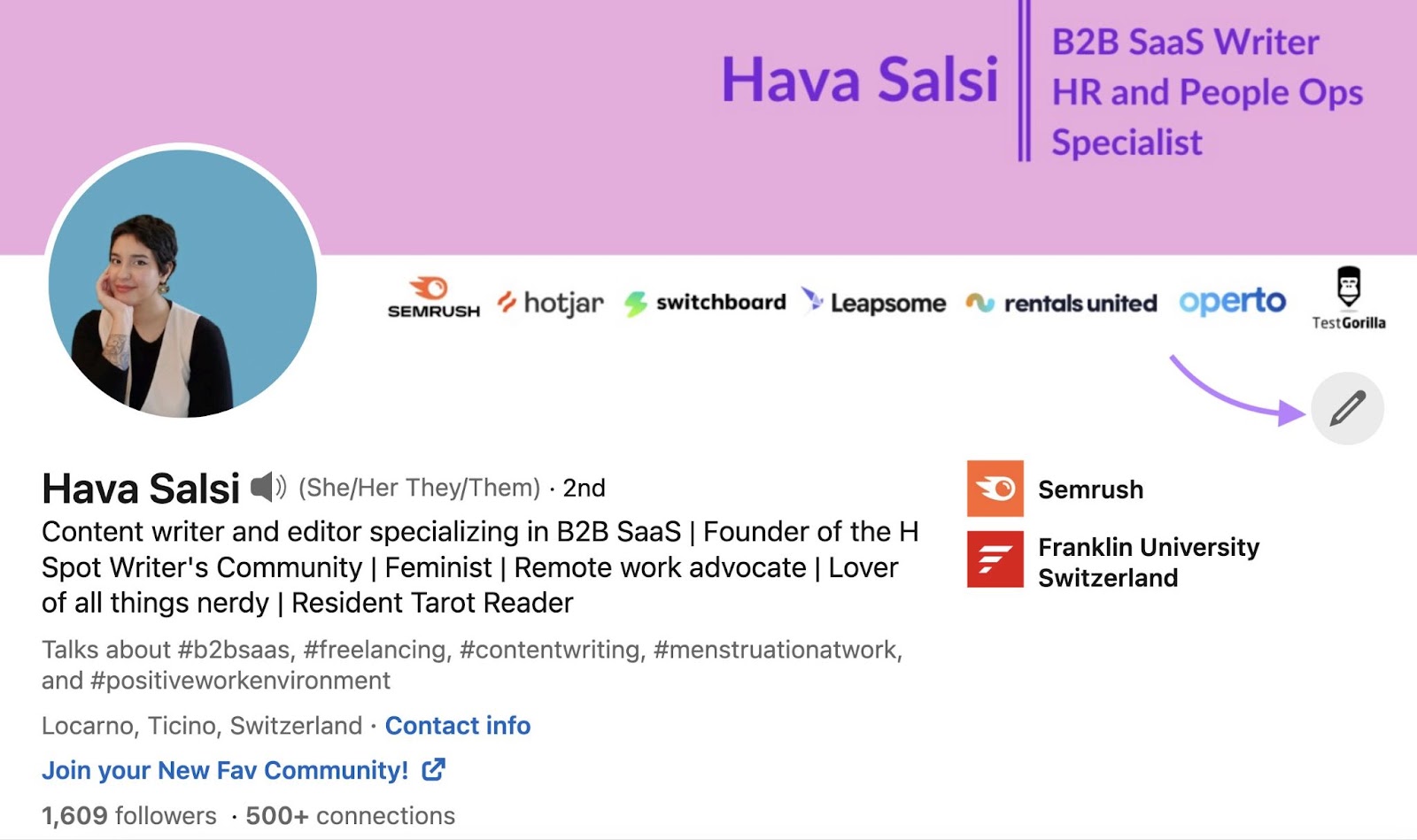
Scroll down to the “Custom button” section and click “Edit custom button.”
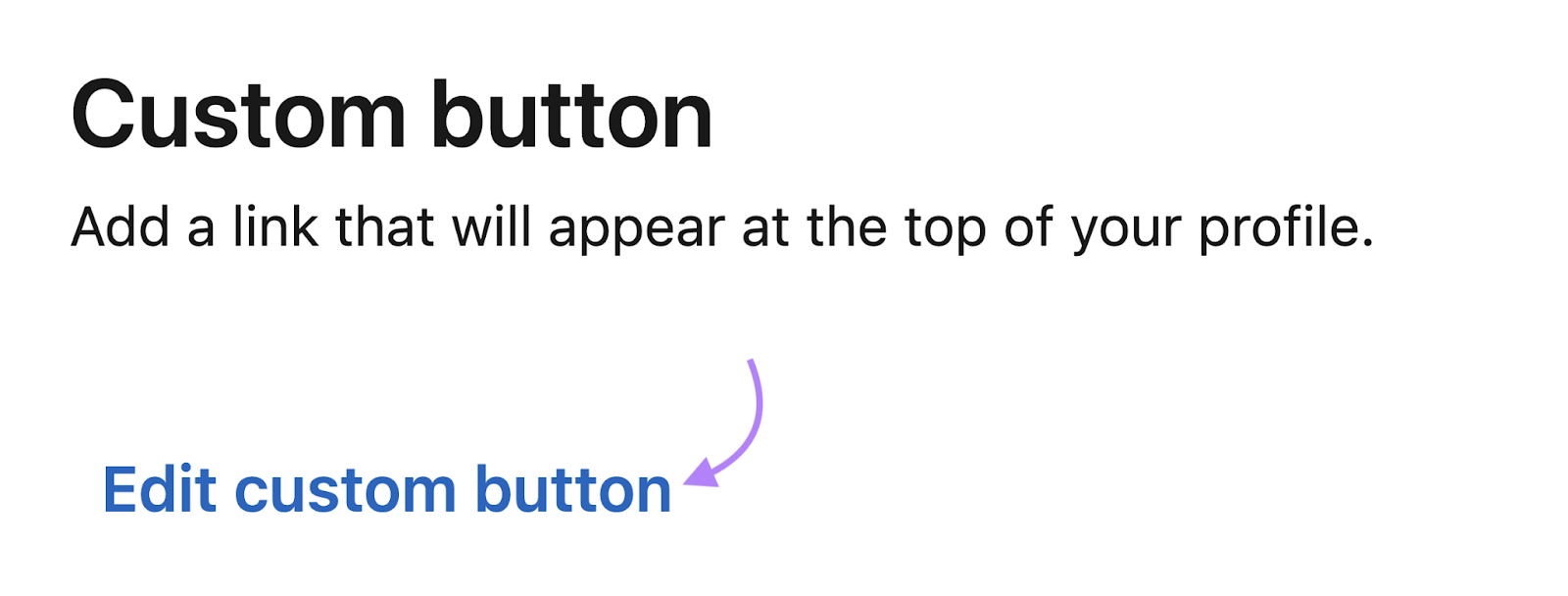
Select the “Link” option. Then add your link and link text in the spaces below.
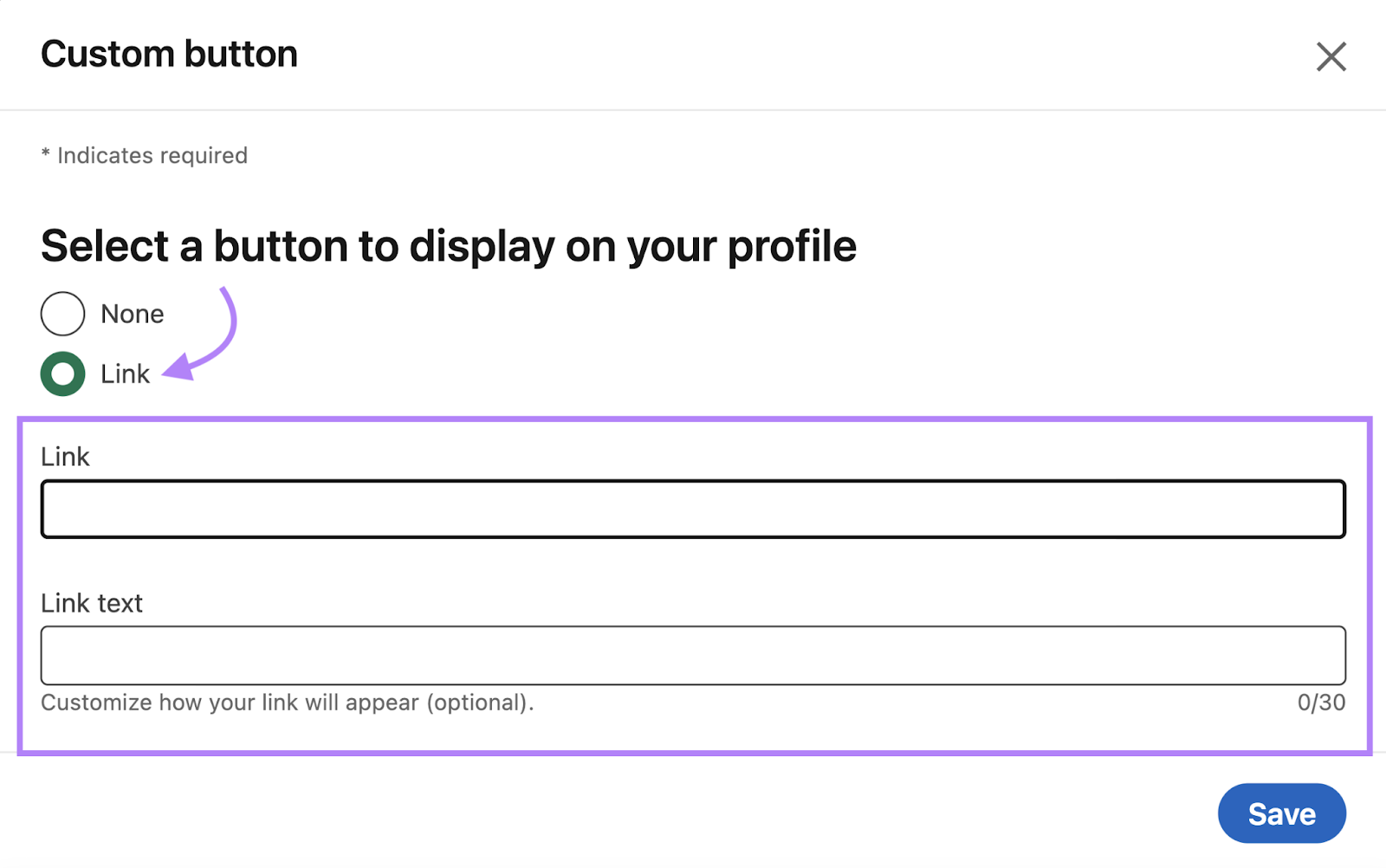
Keep your link text short and straightforward, making it clear what people will see after clicking.
Jumpstart LinkedIn Marketing with Semrush
With a strong strategy and the right tools, you can stand out on LinkedIn, whether personally or professionally (or both).
Semrush’s Social Toolkit gives you a holistic social media management solution to help you manage your LinkedIn, improve visibility, and increase engagement.
This includes:
- Social Poster to help you write, schedule, and post content, keeping you organized and consistent on both personal and business accounts
- Social Analytics for in-depth, historical insights about your business page’s audience behavior and content performance
- Social Inbox to keep on top of your LinkedIn direct messages and replies by helping you organize and respond to them more efficiently
This post was updated in 2024. Excerpts from the original article by Chima Mmeje may remain.
Source link : Semrush.com
